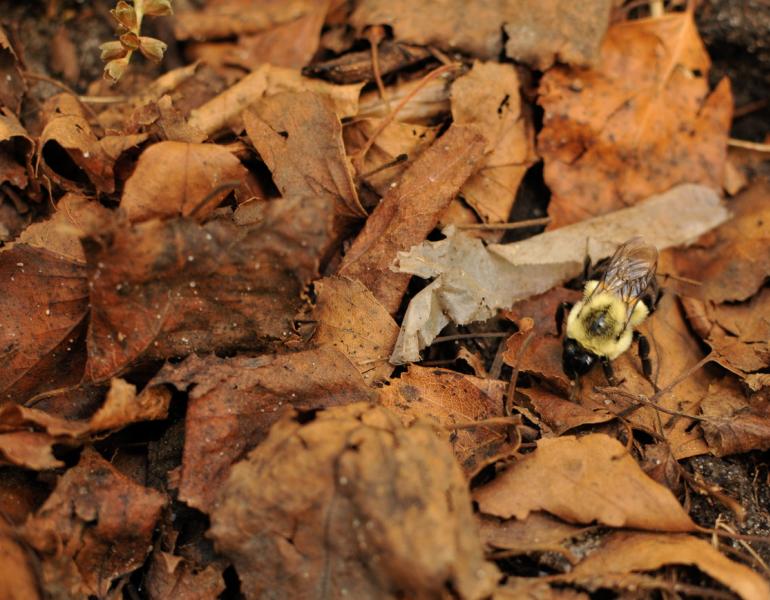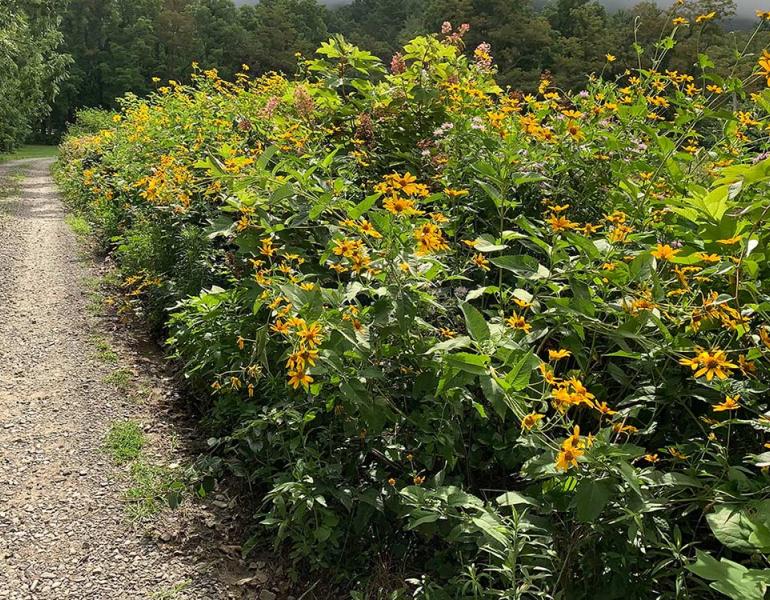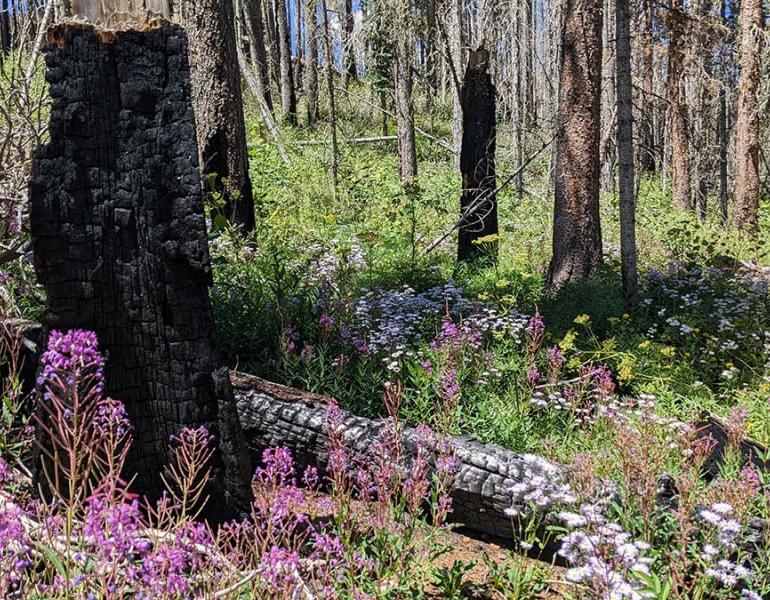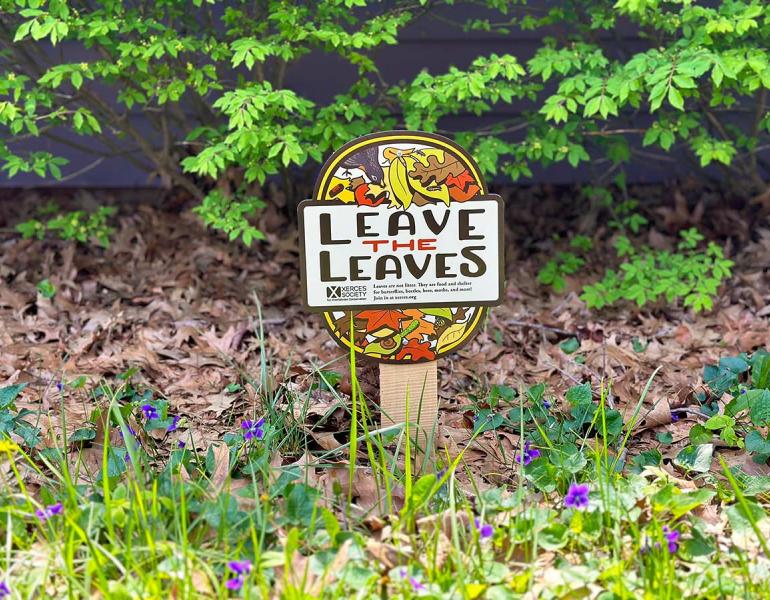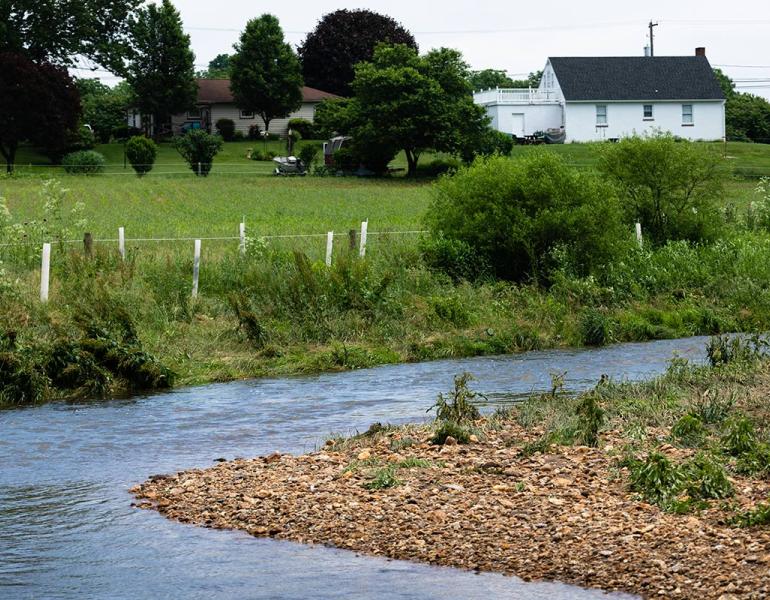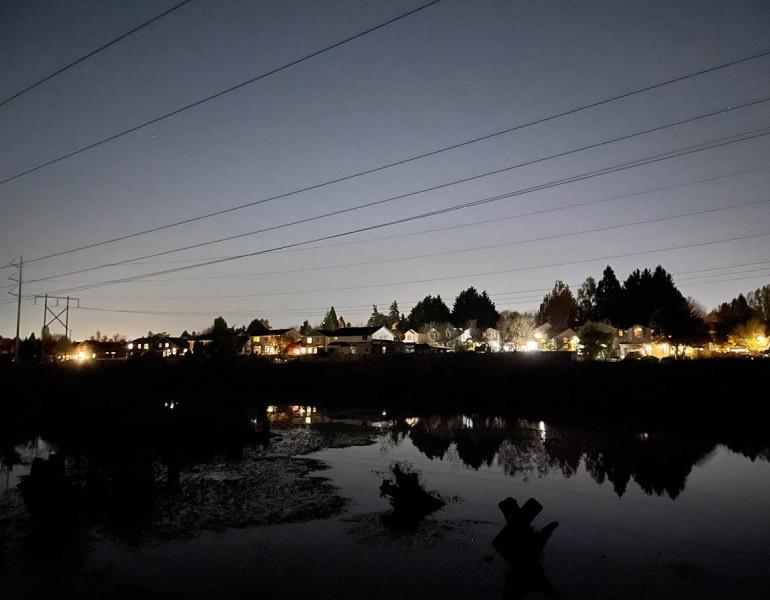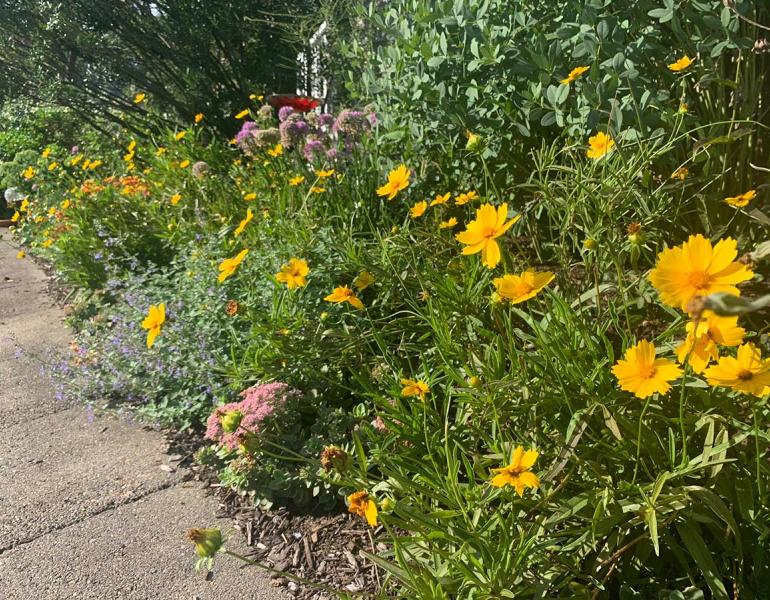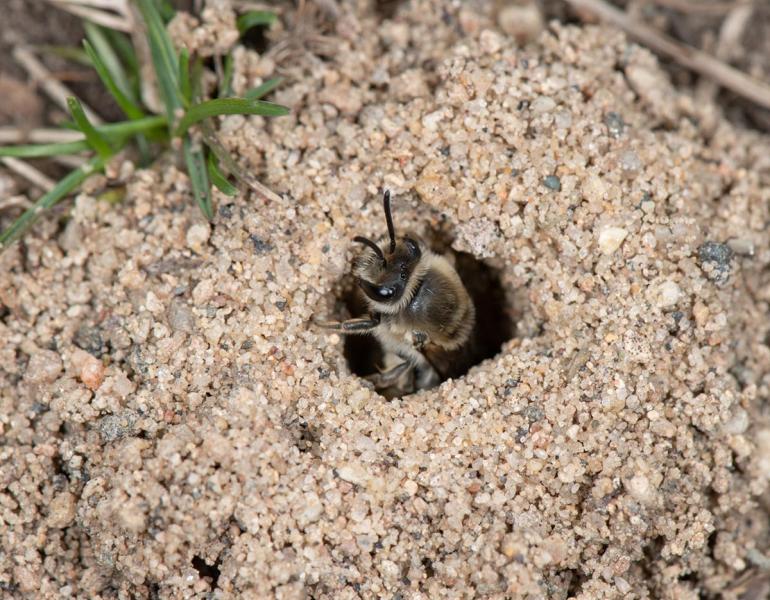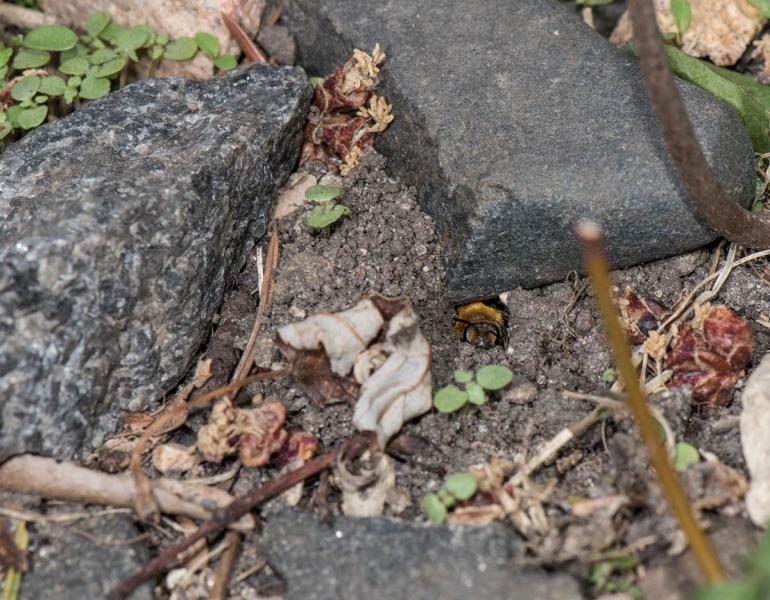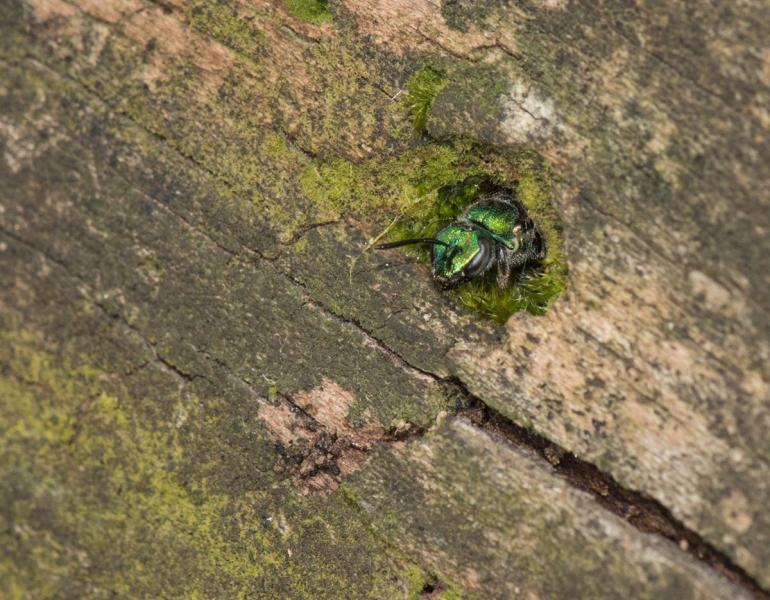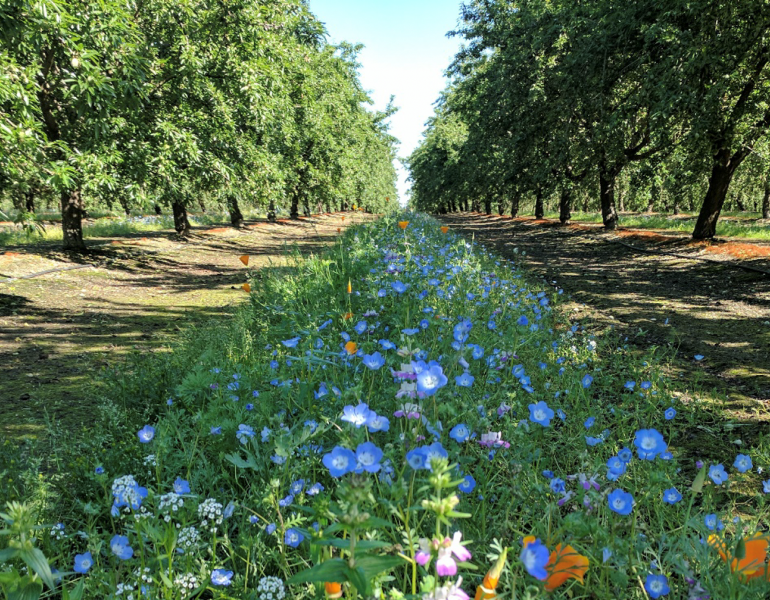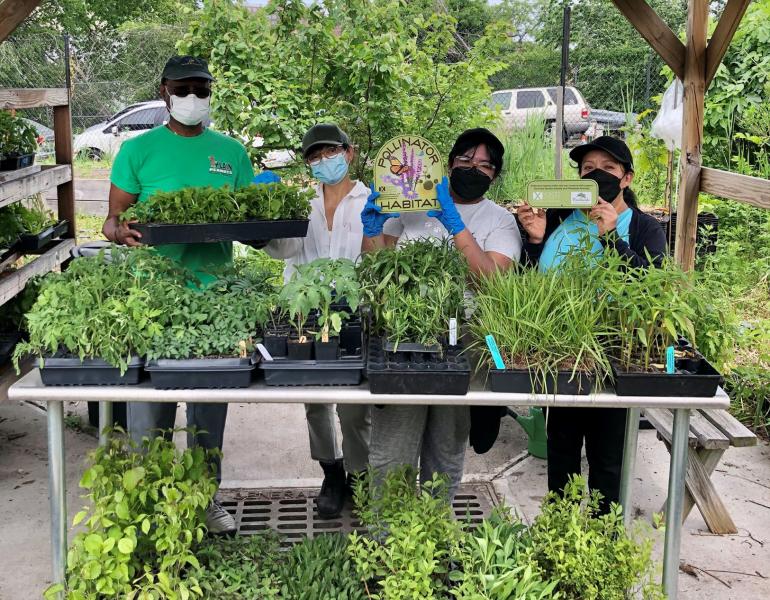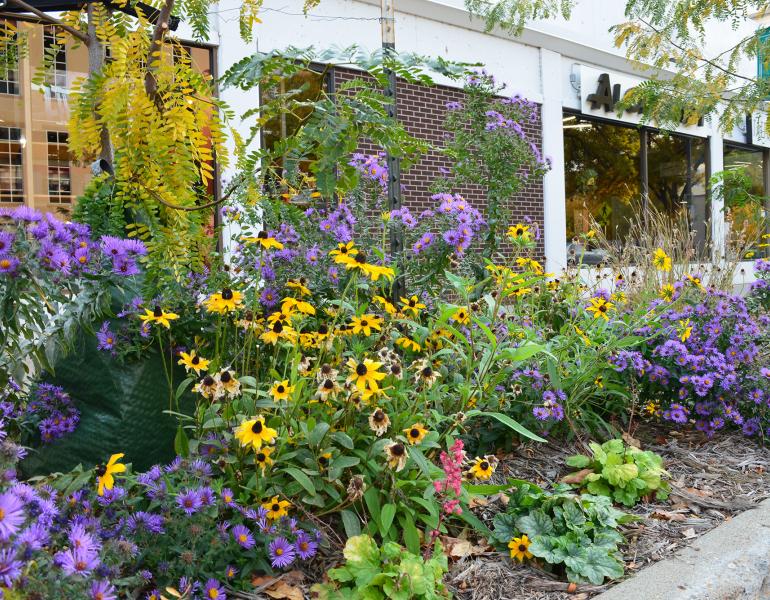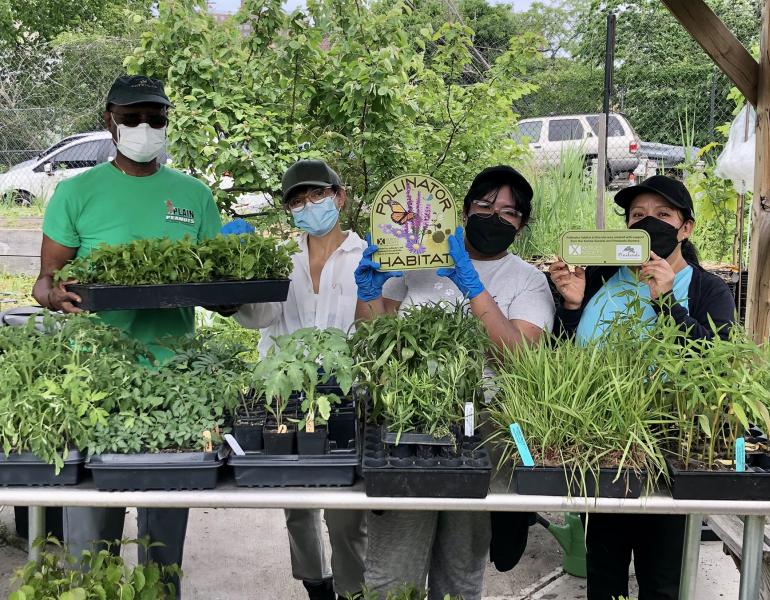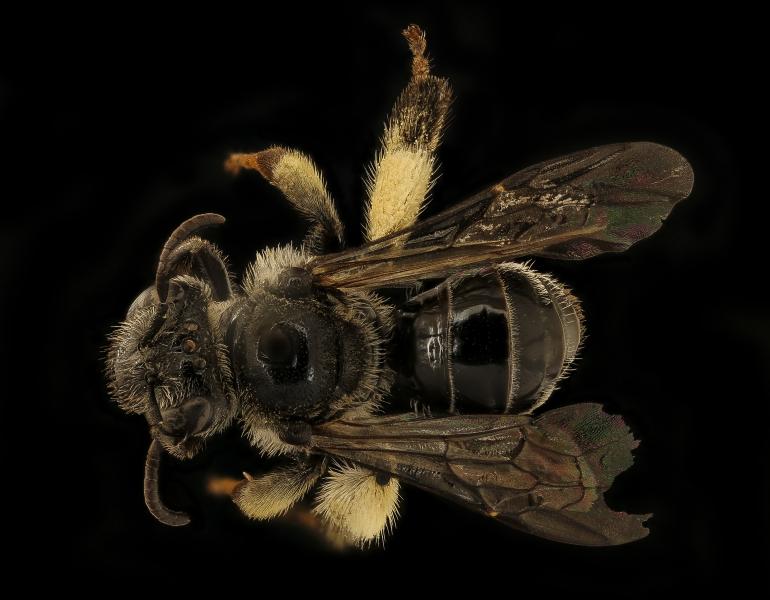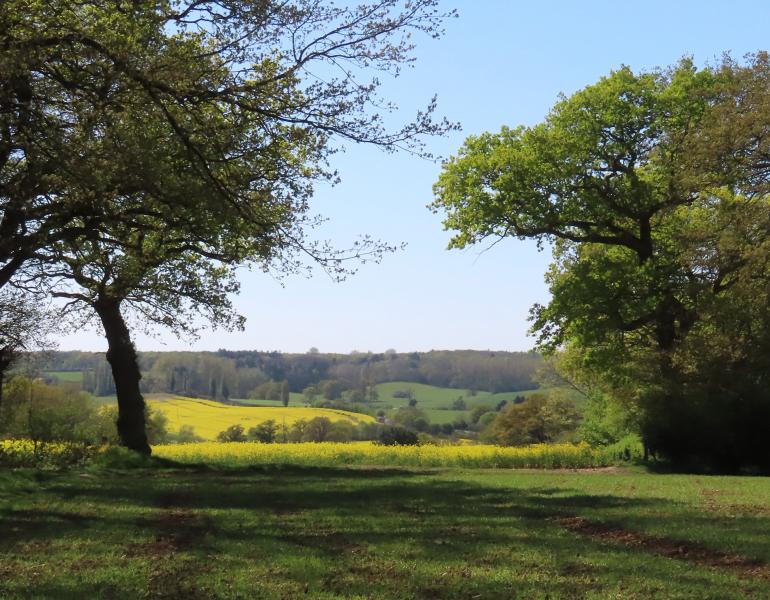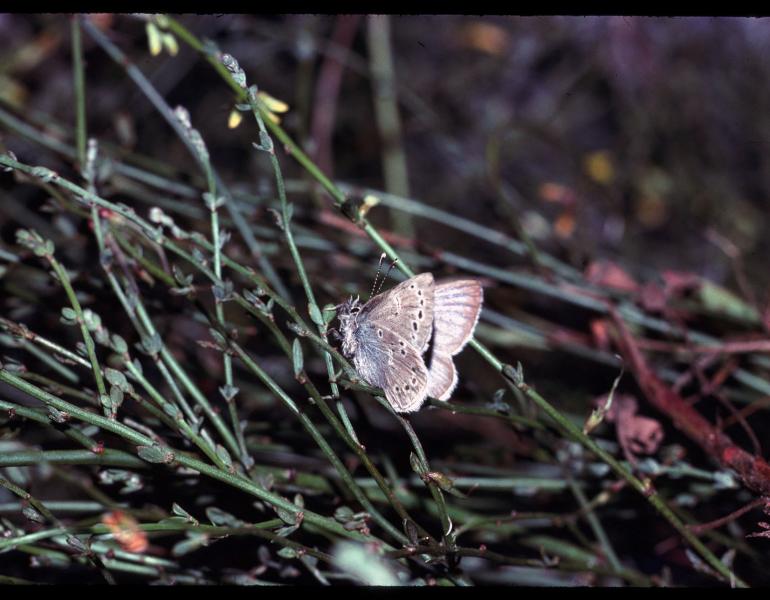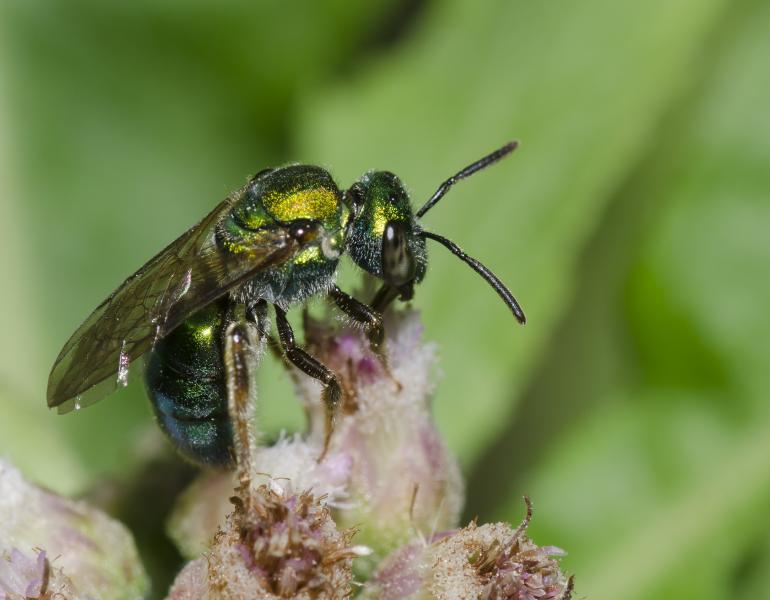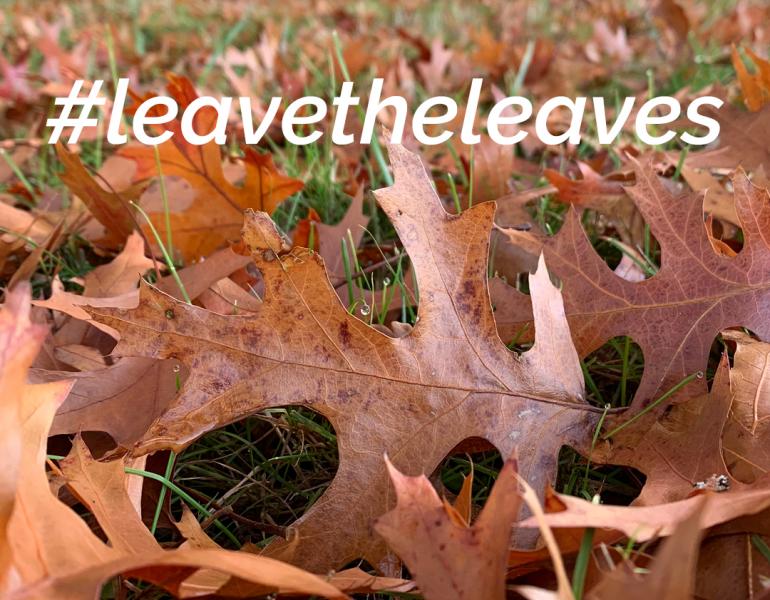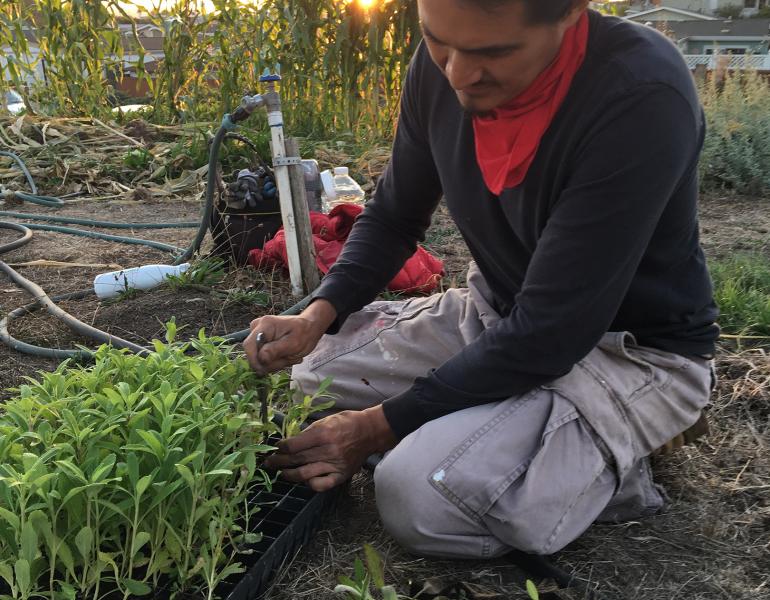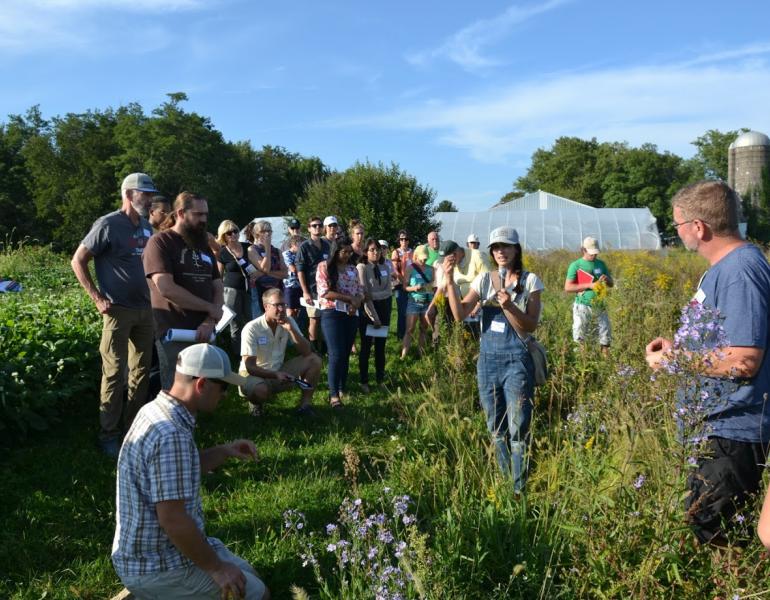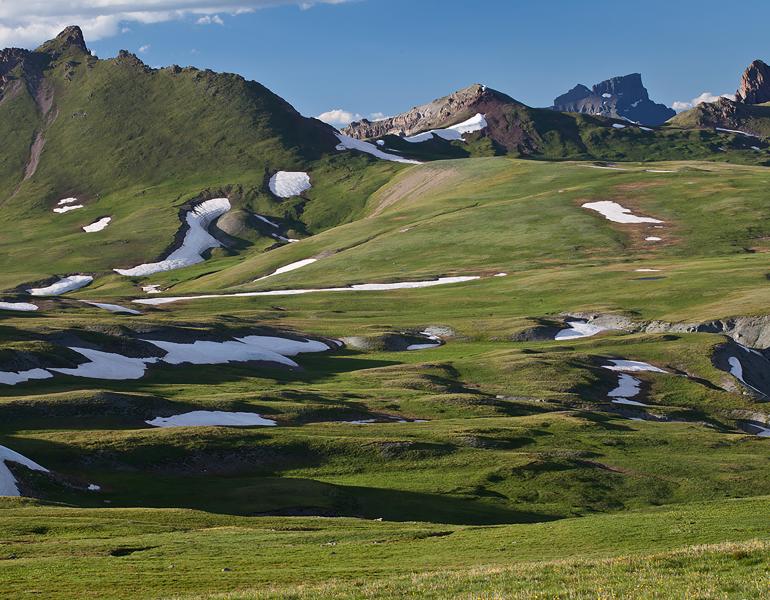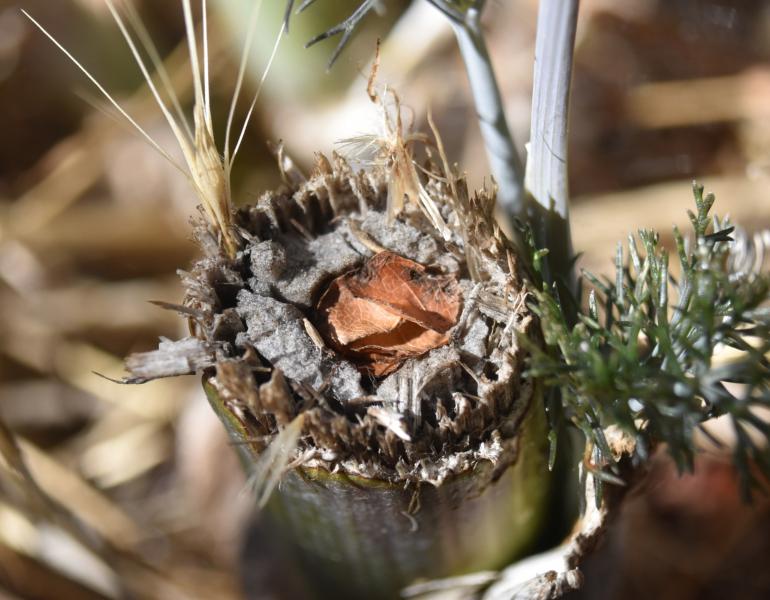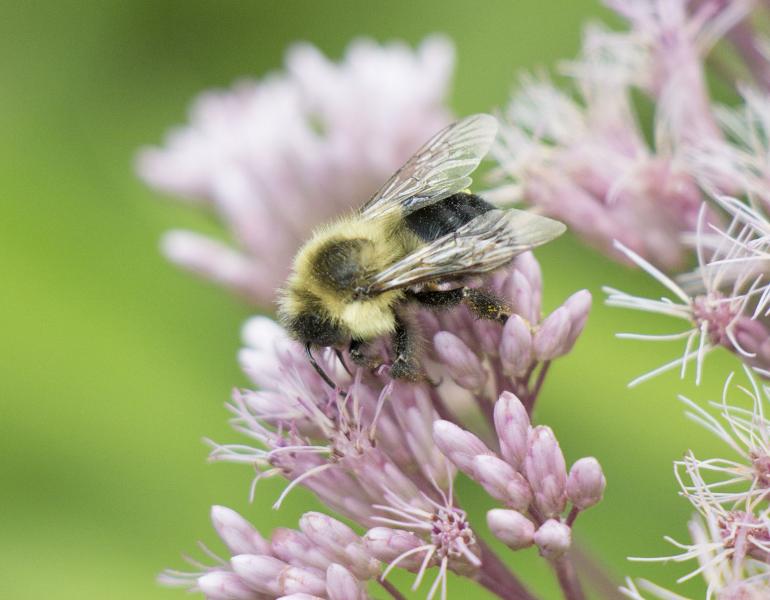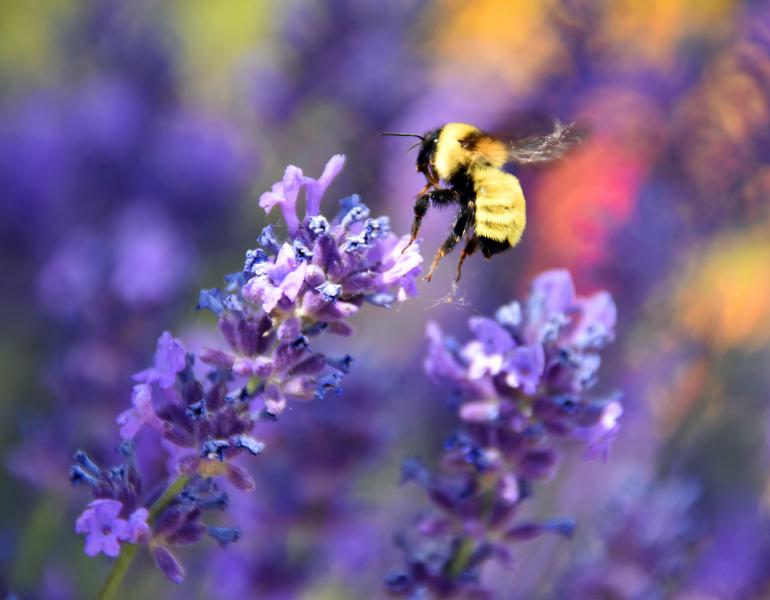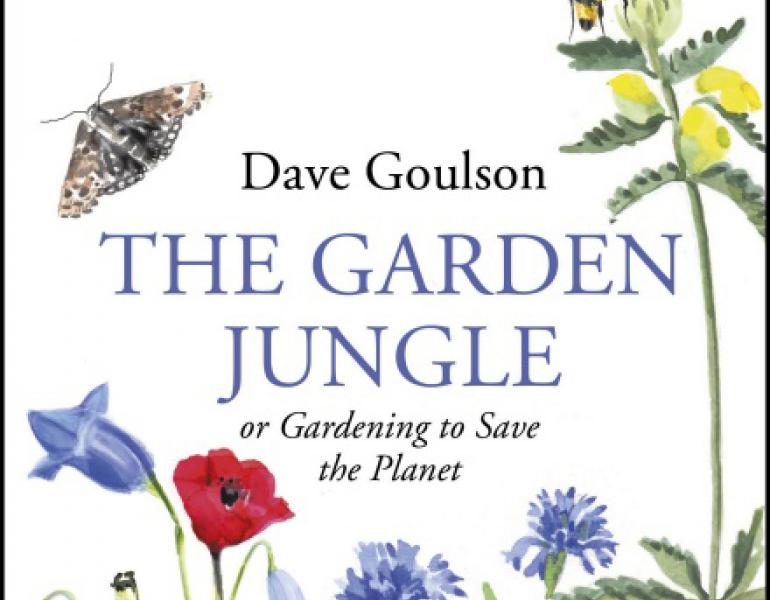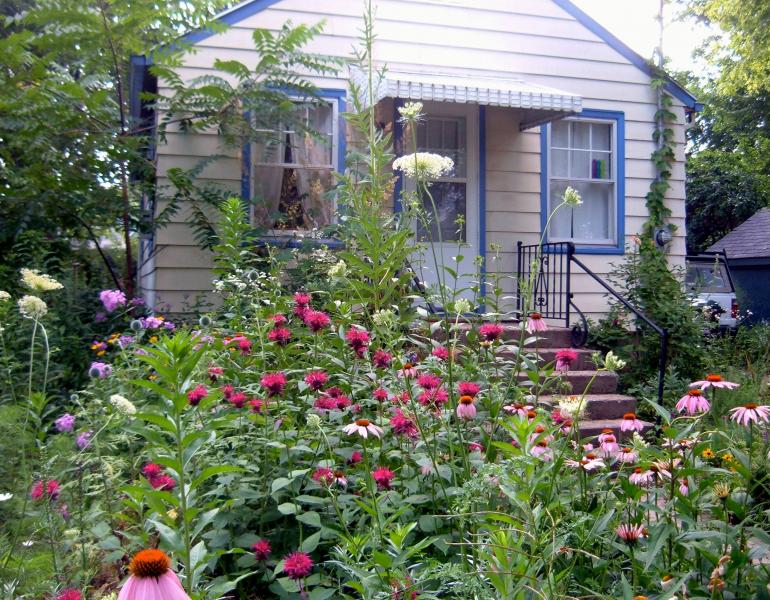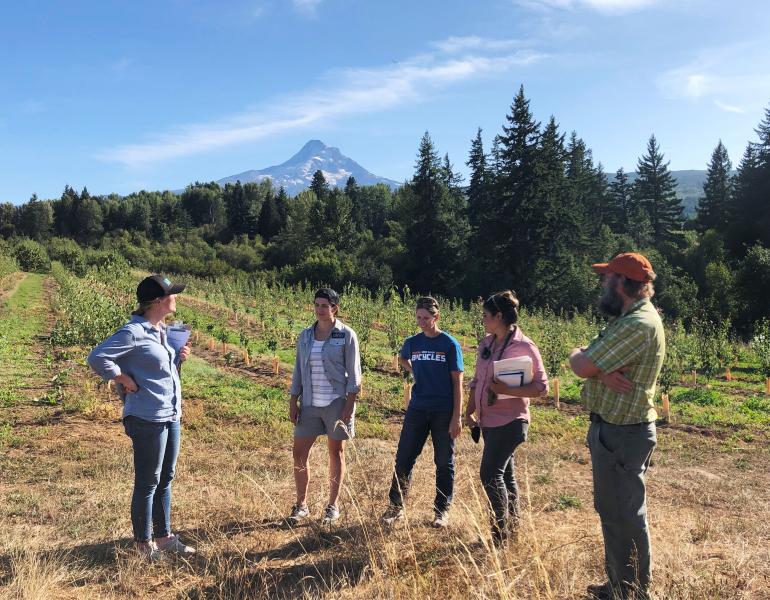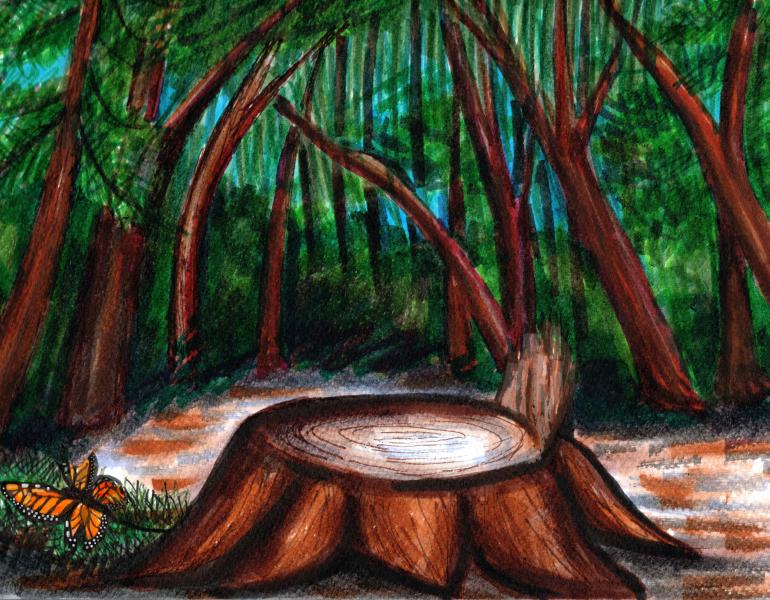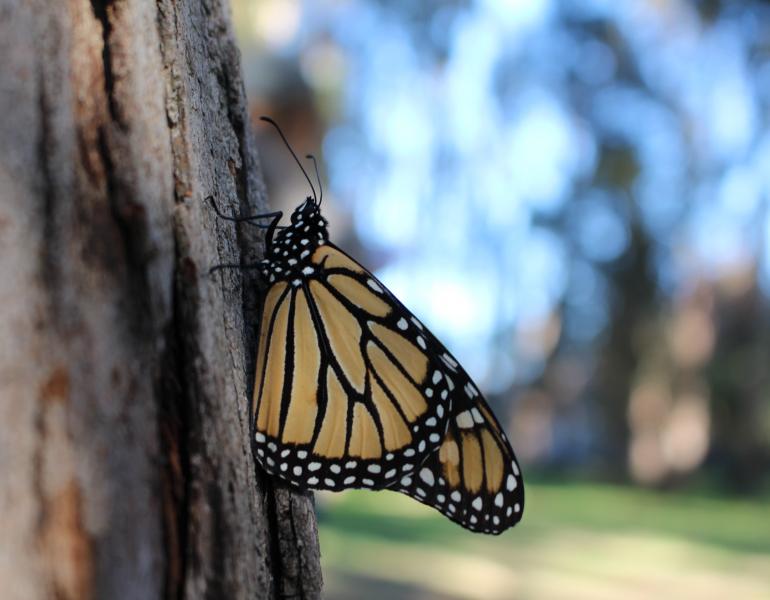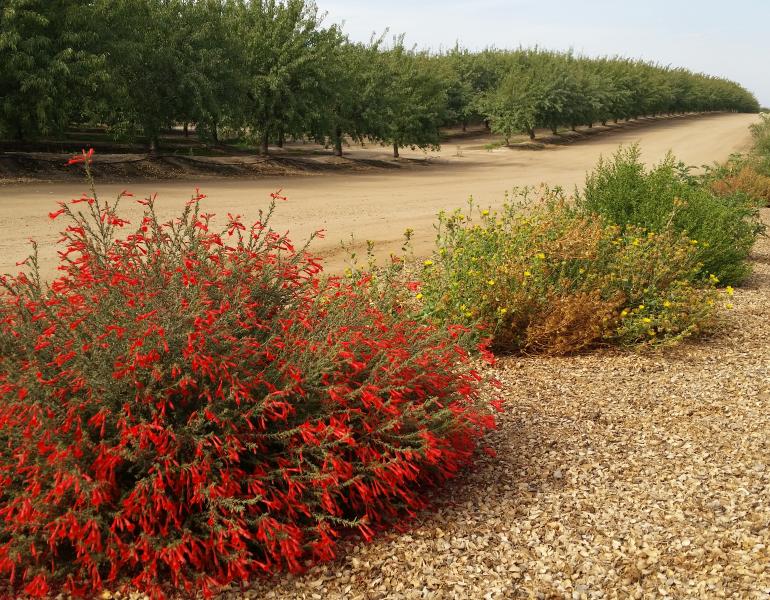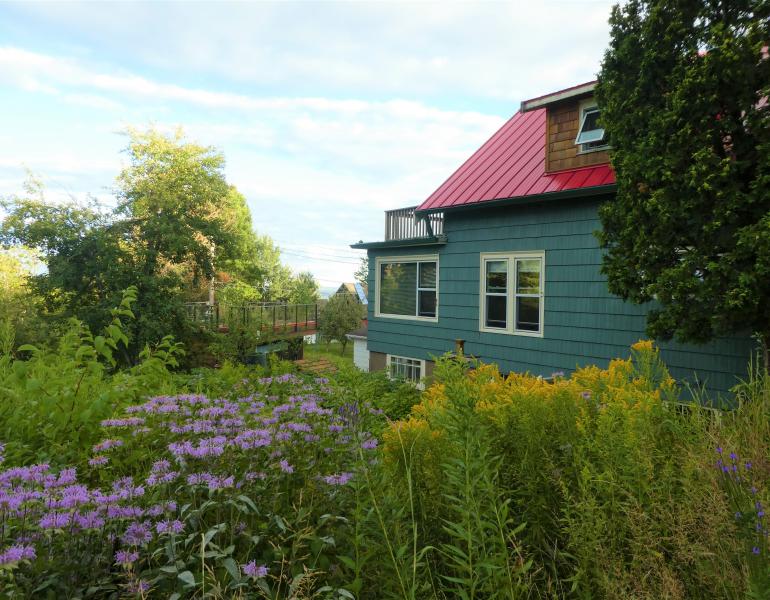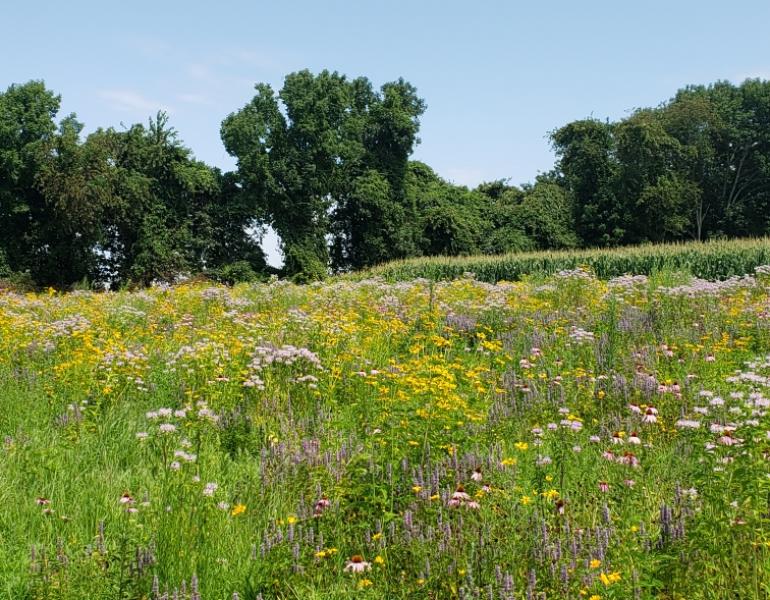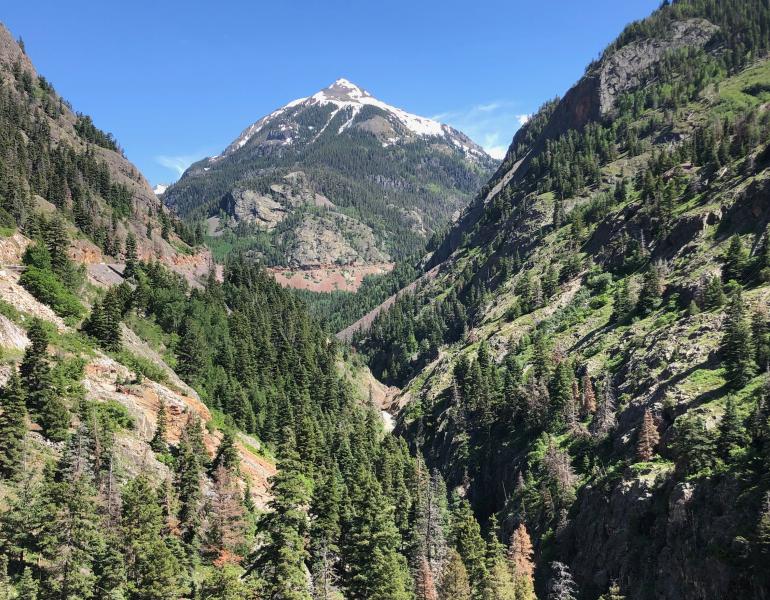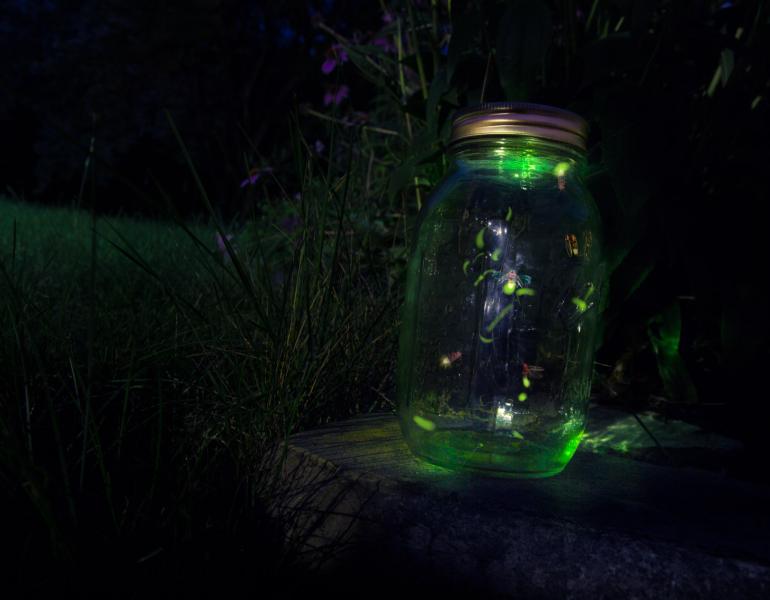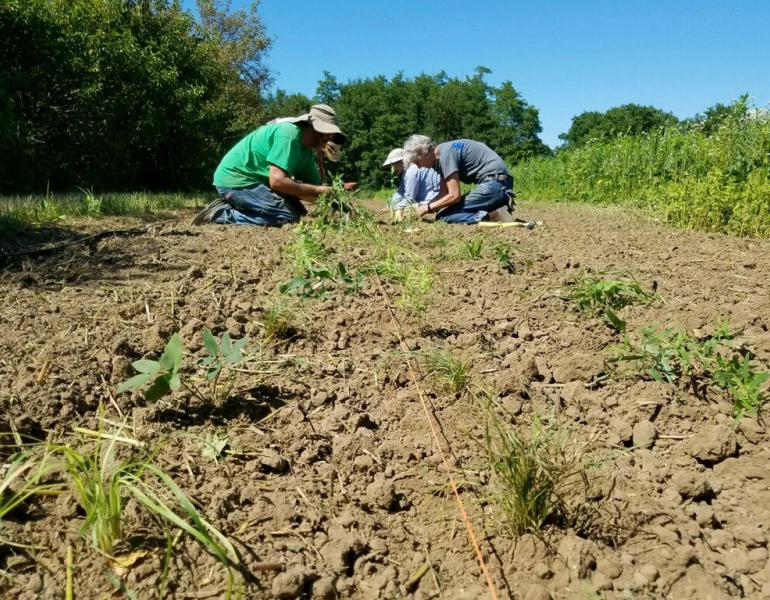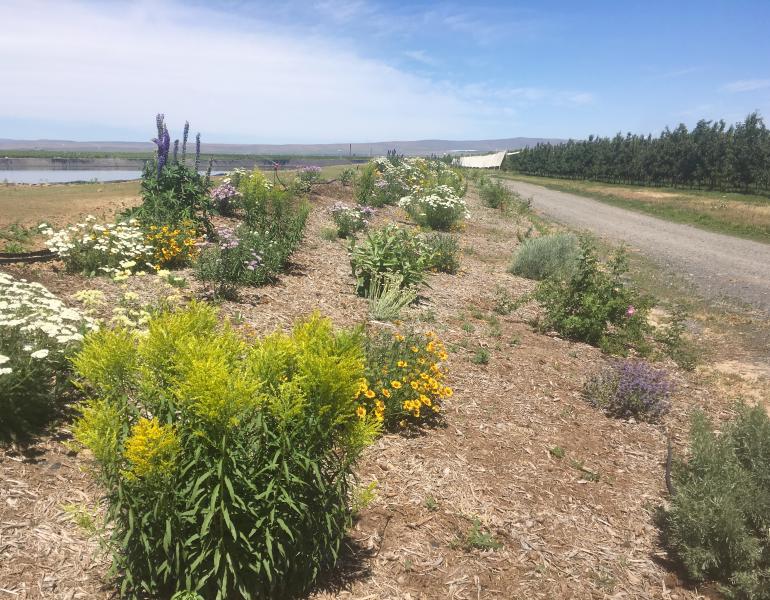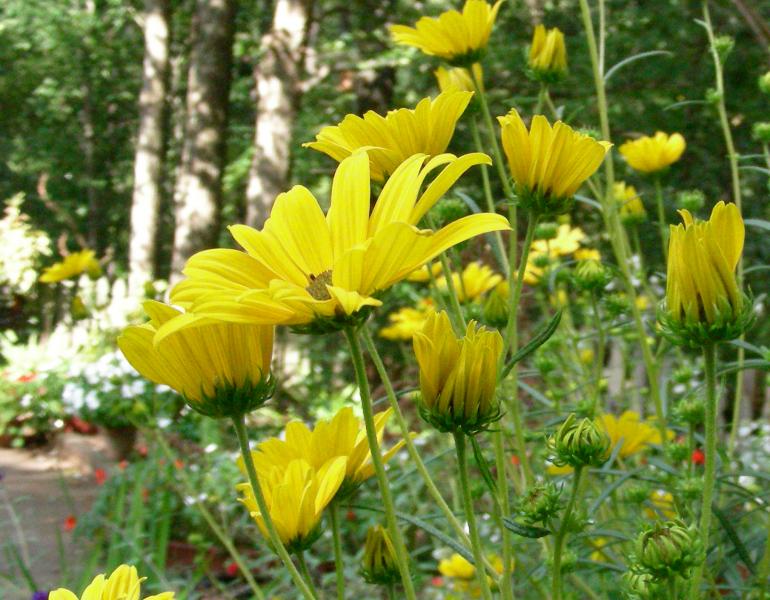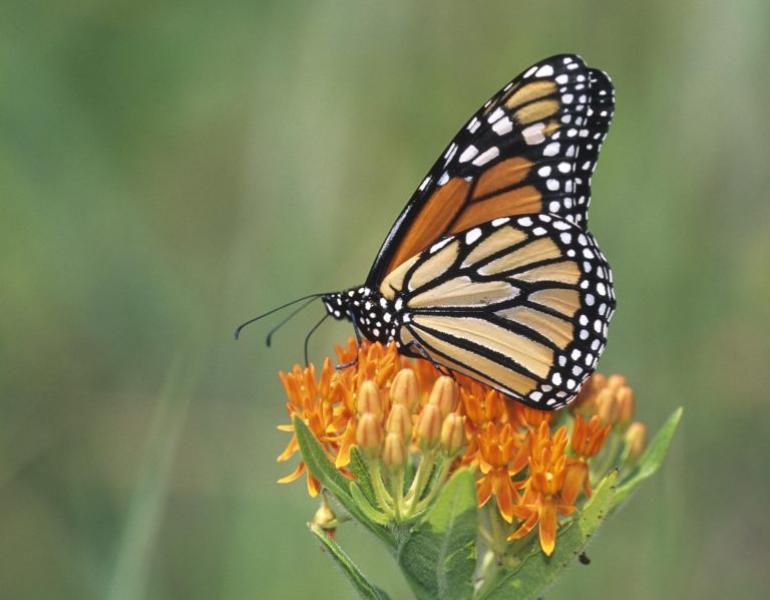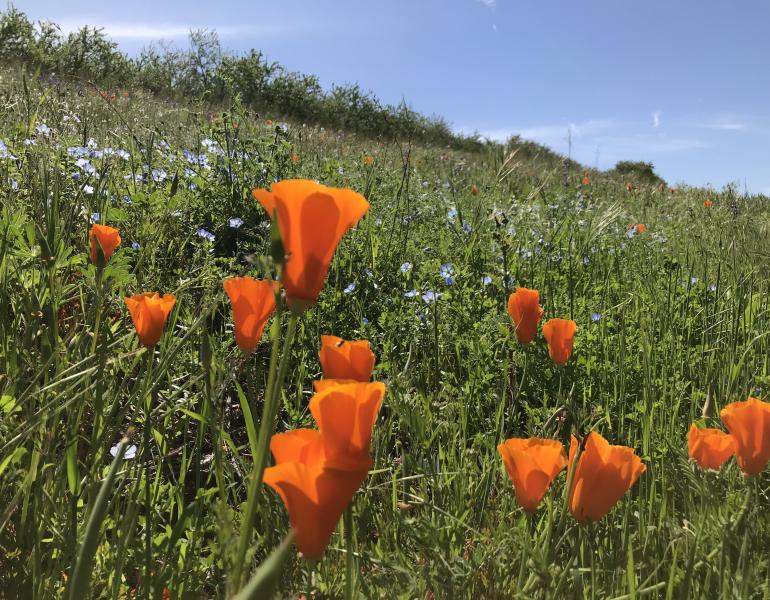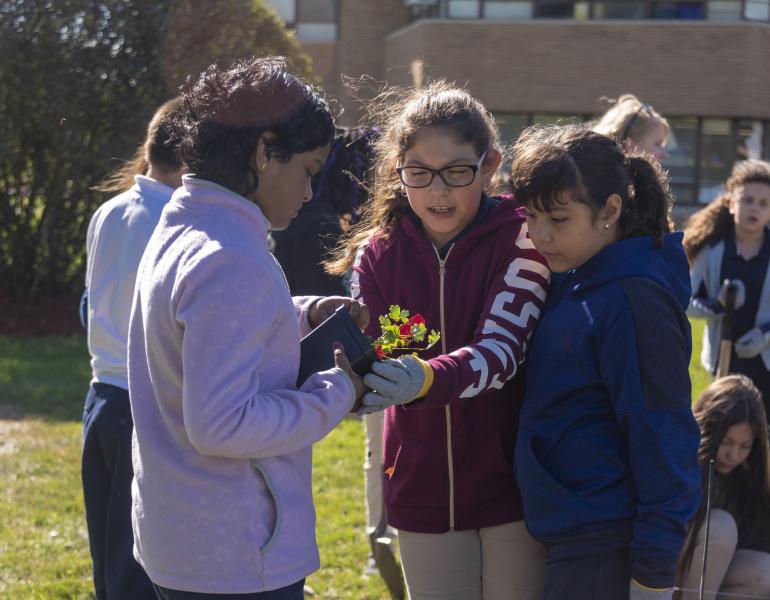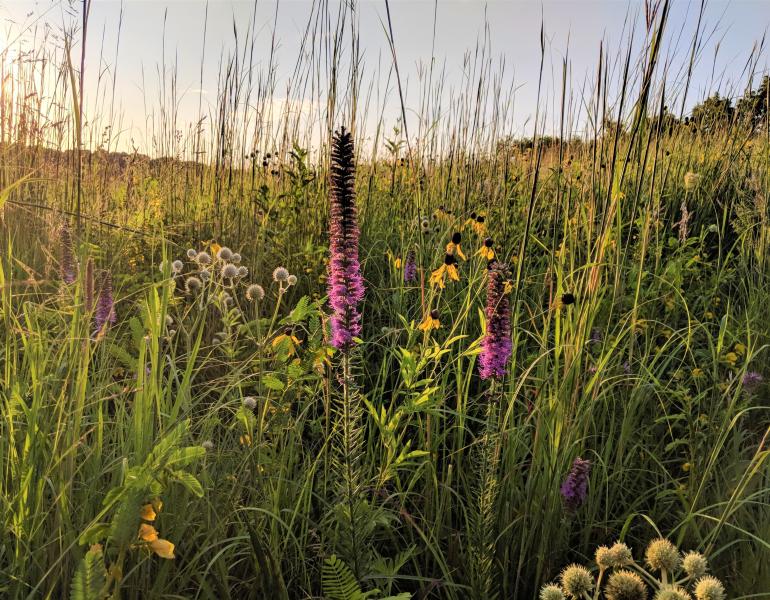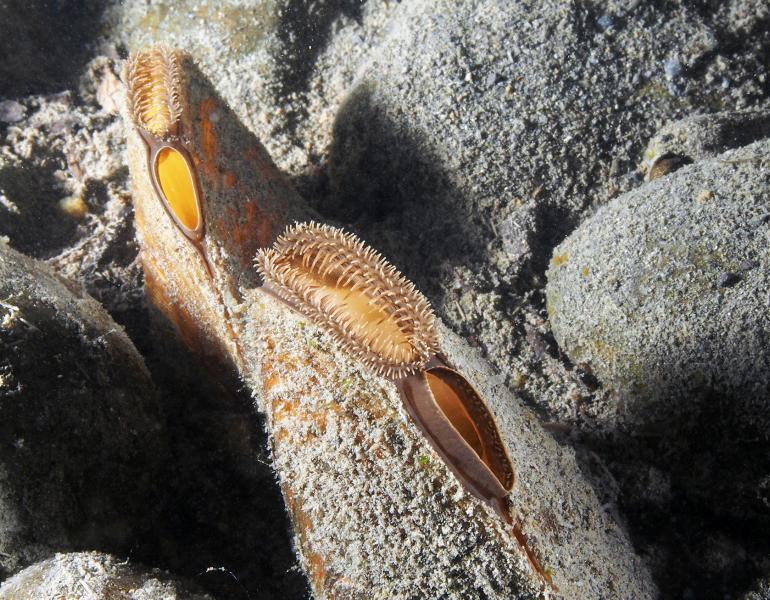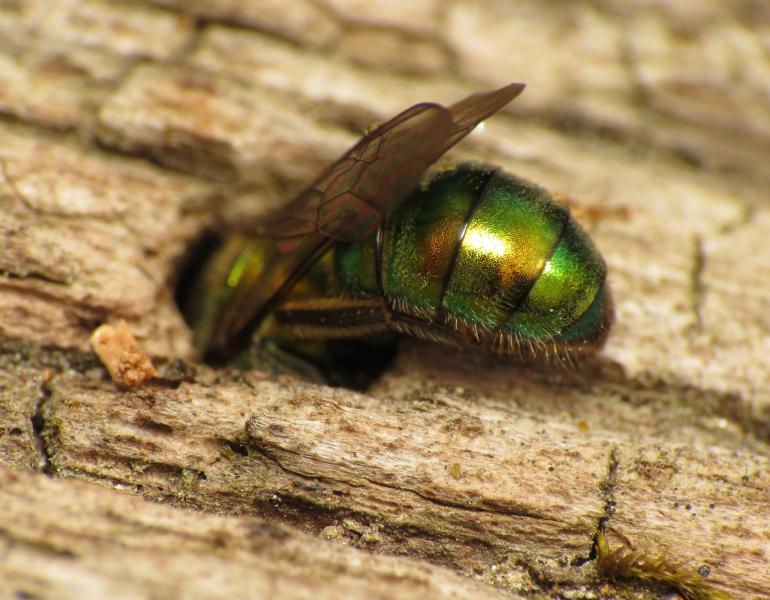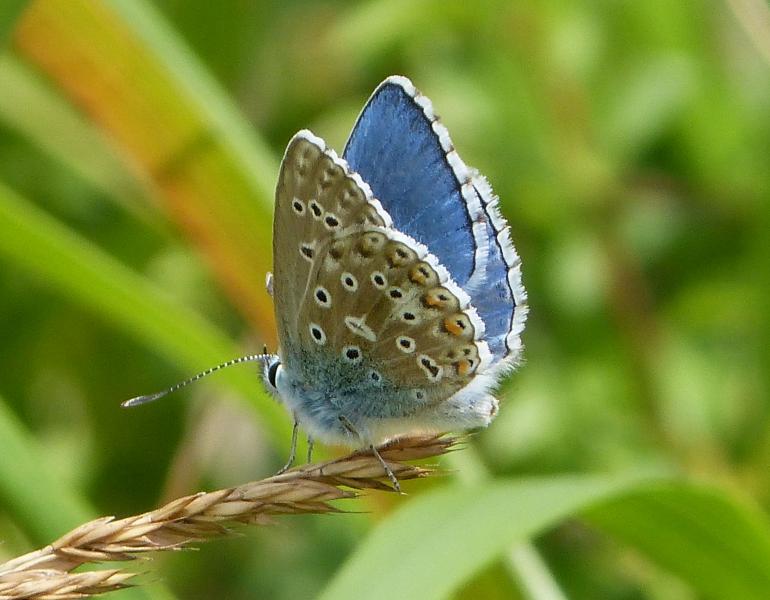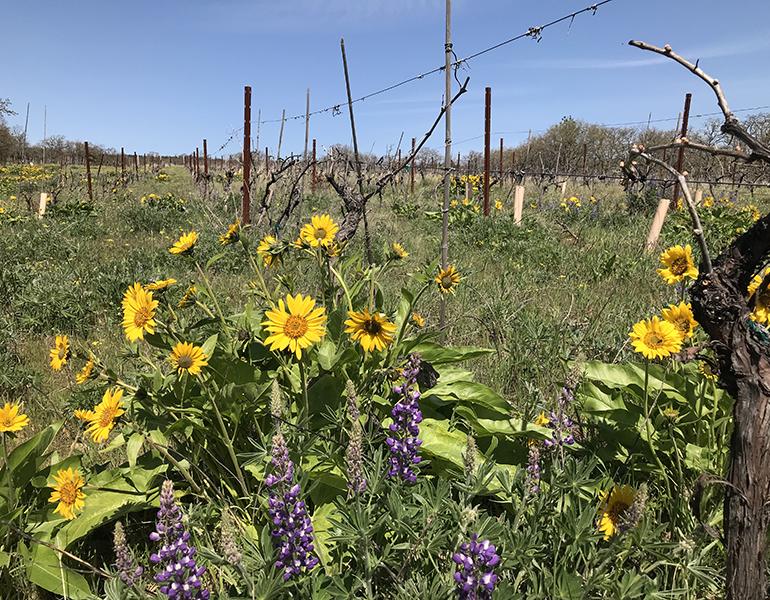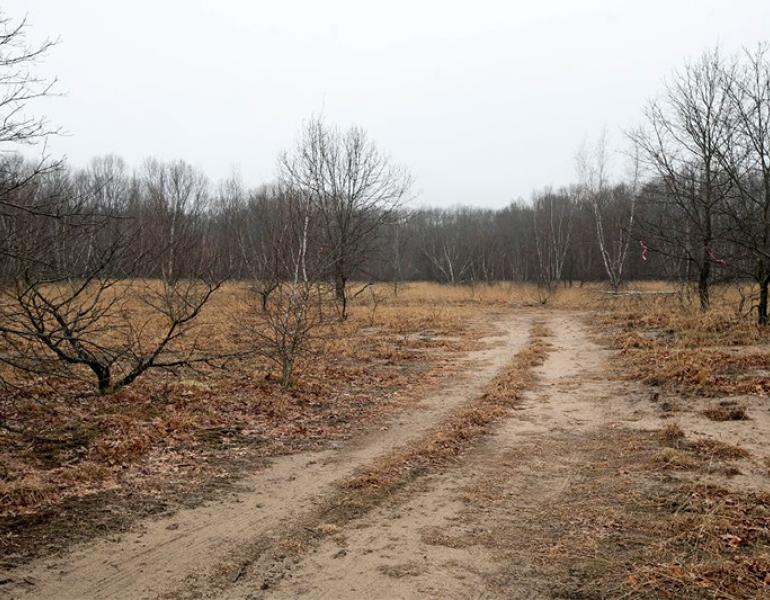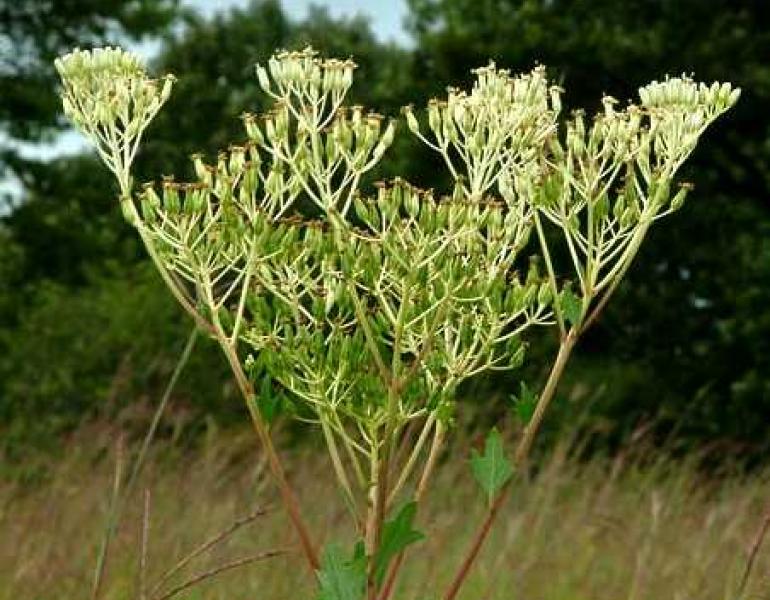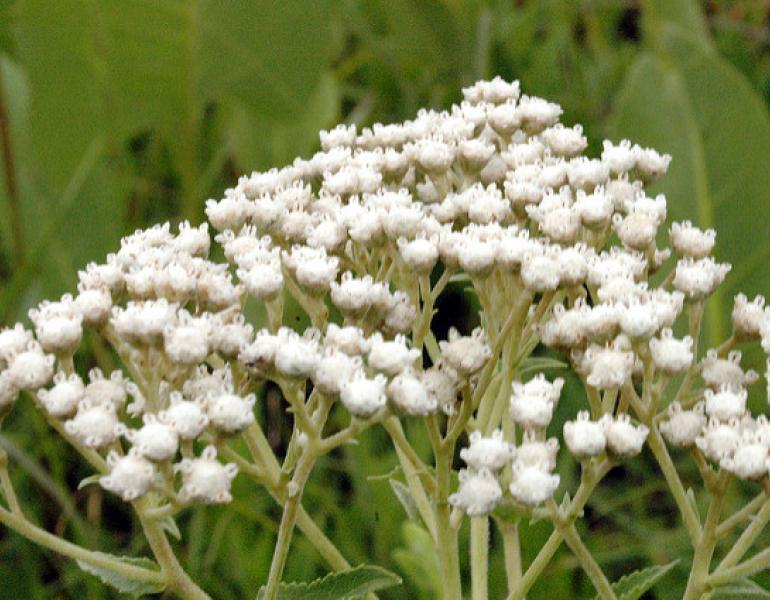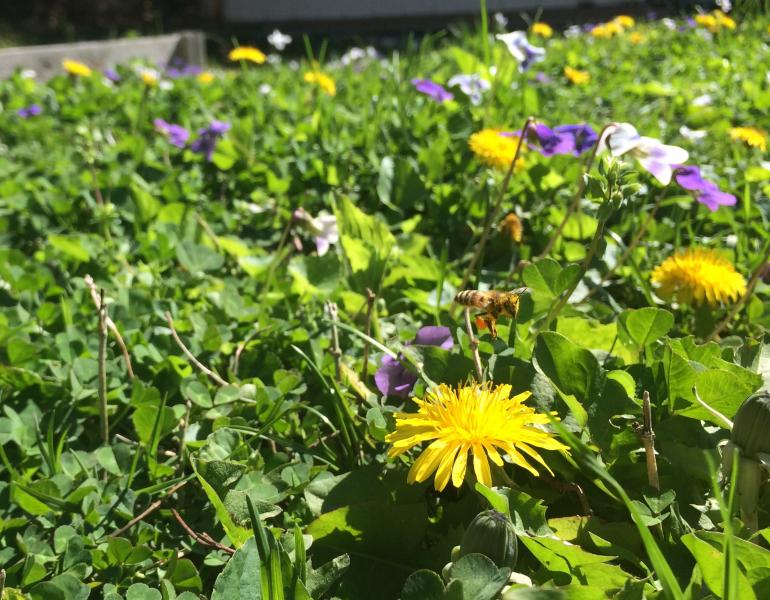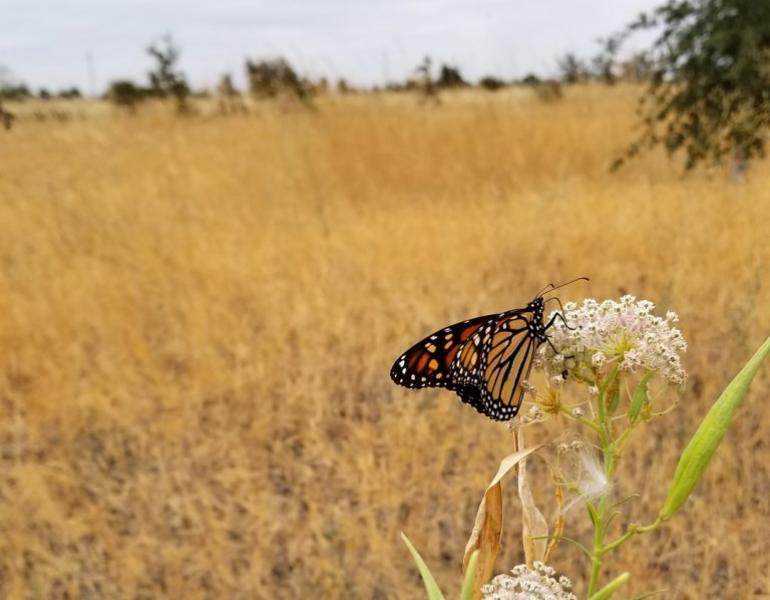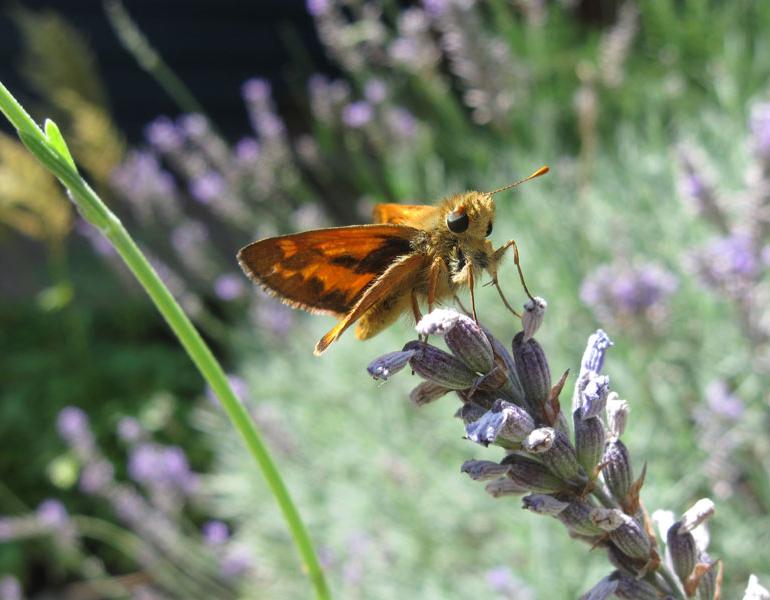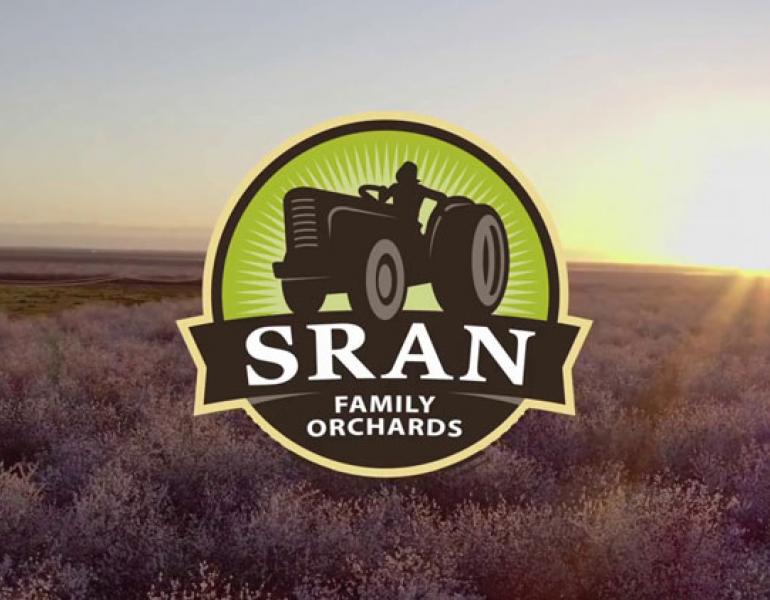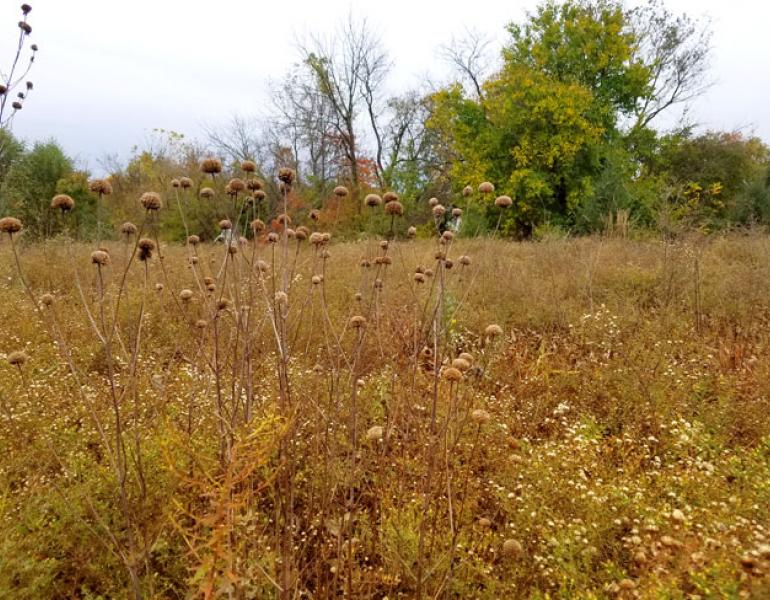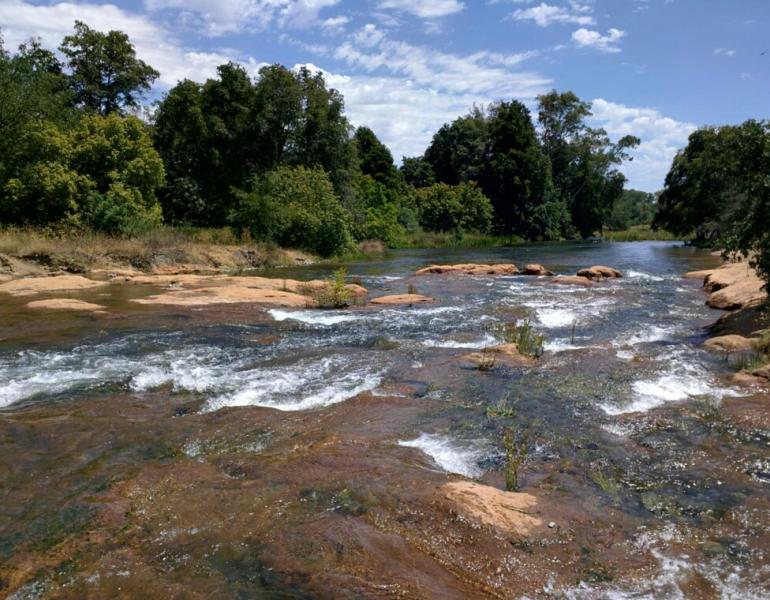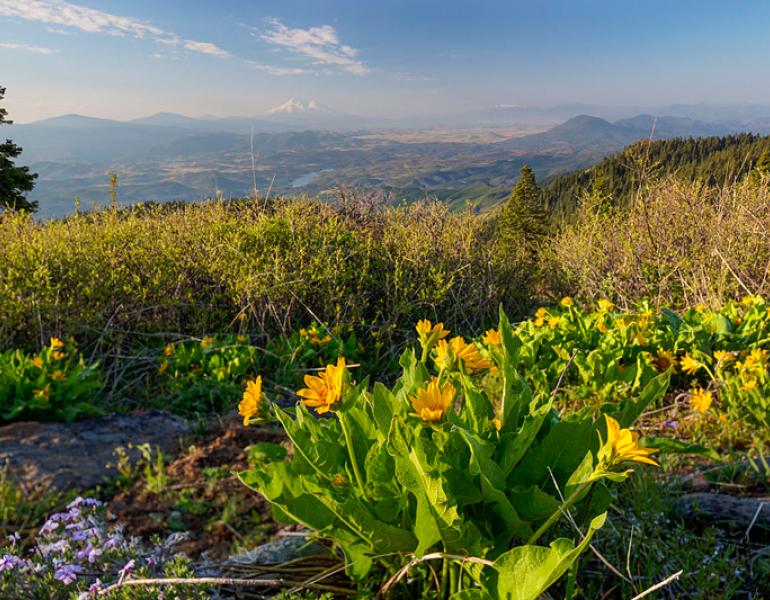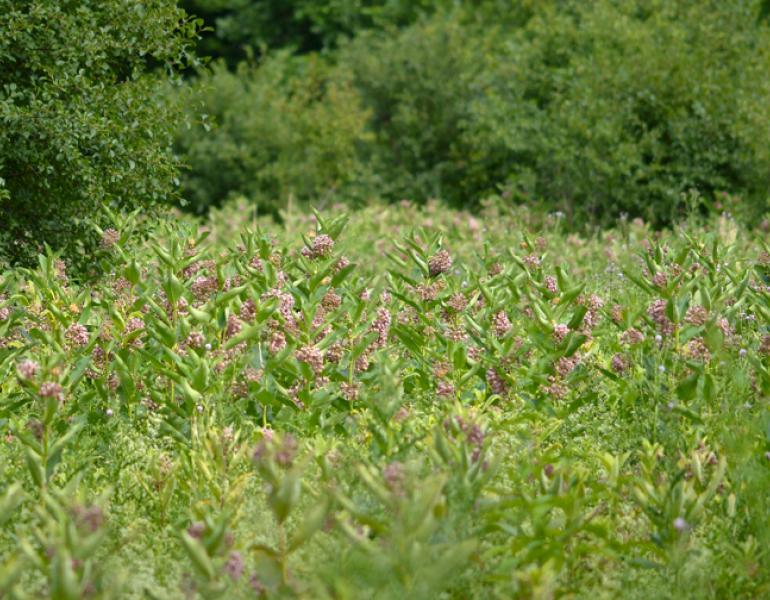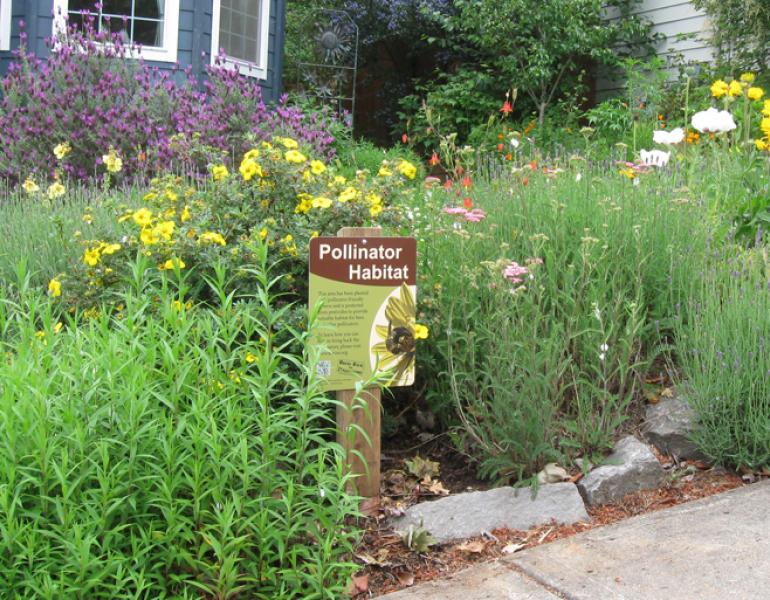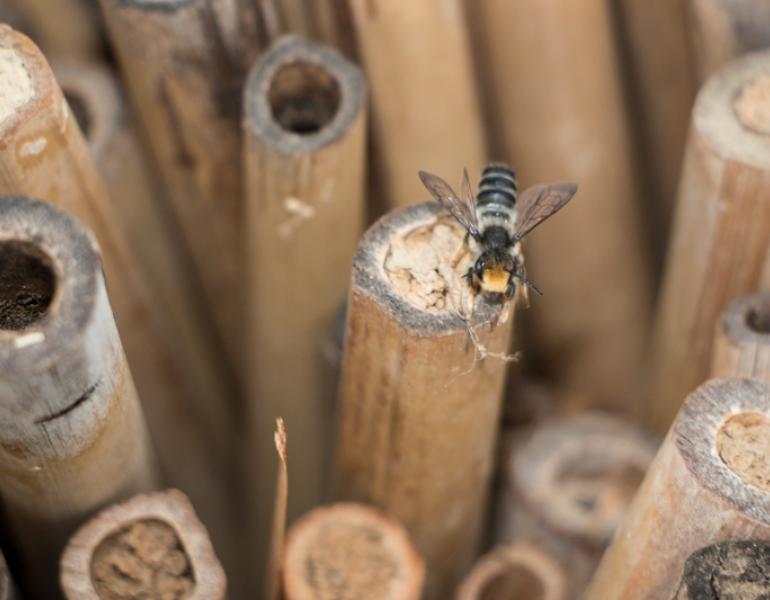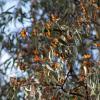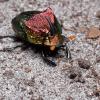Fallen leaves provide year-round habitat for all sorts of beneficial insects that eat pests in your yard!
Habitat
Leave the Leaves!
One of the most valuable ways to support pollinators and other invertebrates is to provide them with the shelter they need to survive the winter. Thankfully, all you need to do is do less yard work.
If You’re Thirsty, They’re Thirsty: Make a Simple Water Source To Support Pollinators
Even a humble puddle can make a big impact for your backyard wildlife. Learn how to make one that fits your space.
All About Hedgerows: Why They Help Wildlife and How to Plant Them
Hedgerows are more than just a living fence! With the right plants, they can be an incredible habitat for pollinators.
Burning for Butterflies: The Role of Fire in Western Forests
While it may seem counterintuitive to burn plants and trees to conserve wildlife, smaller fires are an essential element of many habitats, like ponderosa pine forests.
Put Down Those Pruners: Pollinators Need Your ‘Garden Garbage!’
When you "tidy up" at the end of the season, you're destroying much-needed winter cover for bees, butterflies, birds, and tons of other wildlife.
Inspiration for Pollinator Conservation: Habitat Kits for Urban Farms and Gardens
Stefanie Steele shares her path to pollinator conservation, and her work to help urban farmers add pollinator habitat to their spaces!
Inspiration for Pollinator Conservation: Protecting Waterways with Pollinator Habitat
Julie Michaelson shares her path to pollinator conservation, and her work to build habitat and protect our waterways by surrounding them with native plants!
Inspiration for Pollinator Conservation: Hedgerow Habitat on Farms
Angie Orpet talks about her career path, and her work building pollinator habitat on farms!
To Protect Pollinators, We Need to Fight Light Pollution
Just as water pollution makes every drink dangerous, light pollution puts nocturnal bugs at risk.
Working With Land Trusts To Create and Conserve Habitat Across New England
Erin Cocca shares her experience helping Maine’s Orono Land Trust with their conservation efforts.
They Go with Everything: Even a Small Patch of Native Wildflowers Makes a Difference
Jennifer Hopwood shares how adding even a few plants is the perfect complement to the other habitat features of your yard, garden, or balcony.
Clear Space for Bees: Why Pollinators in Your Yard Need Access To Bare Ground
Open patches of soil and sand, with few or no plants, are a key nesting habitat for the majority of native bees, and easy for us to provide.
Wildlife on the Rocks: Providing the Rocky Habitats Bugs Need for Shelter
Rock piles and stone walls might seem like they take yard space away from plants, but these features are crucial to support a diverse wildlife community.
Tiny Places for Tiny Animals: Building the Microhabitats that Bugs Need to Thrive
It’s easy to add small features, like a brush pile, dead stems, or a leafy corner that can make a big difference for wildlife! Here's how.
Why Monarchs Need Early-Season Milkweeds
Western monarchs need milkweed for breeding as soon as they leave their overwintering sites. That's why we partnered on a project to make early-season native milkweed more available in California.
Planting for Bees, Butterflies, and Beauty in the Bronx
Two urban farms in the Bronx demonstrate a symbiotic relationship between people and pollinators. Communities at the Garden of Happiness and Tawqua Community Farm restore quality pollinator habitat and pollinators keep the gardens thriving and producing.
More Than Food: A New Roadmap for Agriculture
In recent years, invertebrates on farms have received a little more mainstream attention, often under the broader umbrella of “regenerative agriculture,” a loosely defined philosophy that proposes farms should improve rather than diminish natural resources. With supporting investments from the USDA National Resources Conservation Service (NRCS), the Xerces Society recently inaugurated a five-year, multi-state research and development project focused on evaluating conservation practices that simultaneously maximize climate resilience, biodiversity, and market incentives.
Conserving Desert Pollinators and Water in the Face of Climate Change
One of the most immediate and tangible ways we can prepare for climate change as individuals is to restore native habitat. This not only builds a greater buffer for plants and animals to survive changing conditions, but makes our own gardens and landscapes more prepared to withstand drier or wetter, hotter or colder weather. While it will take everyone to stop rising temperatures at a global scale, I find hope in the cultivation of little patches of earth throughout Santa Fe hosting pollinator habitat kits.
Meet the Partners Saving Pollinators with Xerces’ California Habitat Kits
Over the past three years, Xerces’ California Habitat Kit program has given away over 105,000 plants to partners all across California who are interested in creating habitat for monarchs and other pollinators. We’ve been able to work with some really great people as part of this program who have helped to create habitat in a variety of landscapes.
Habitat Kits: Partnering to Support Monarchs and Pollinators
Since 2019, the Xerces Society Habitat Kit Program has united Xerces, local residents, and native-plant nurseries to offer regionally appropriate plant materials grown to order by nurseries and supplied to our community partners. In return community members provide sweat equity: the time, the labor, and land. The habitat kits not only help people plant and nurture habitats that support monarchs and other pollinators, but they also remove financial barriers for groups and individuals who want to help.
Climate News: Nature-Based Climate Solutions Address Climate Change and Support Pollinators
Habitat restoration can contribute to countering climate change. Native trees, shrubs, flowers, and grasses increase carbon sequestration, while also providing habitat for butterflies and bees.
The Return of Wild Pansies at Polk City Cemetery
In Iowa, volunteers are working hard to restore an area of old prairie. They are seeing signs that the grassland is recovering, including the regrowth of pale coneflowers and wild pansies.
Pollinator Conservation Program Digest – July 2021
In July's Pollinator Team Digest, Sarah Hamilton Buxton describes a multi-organization collaboration bringing pollinator plantings to the heart of Bismarck, ND, and Jennifer Hopwood introduces the amazing life beneath our feet that is at the center of a new conservation initiative focused on soil life.
Pollinators Find a Home on Roadsides
State Departments of Transportation manage millions of acres of land and have an opportunity to make a significant difference for pollinators. Roadsides provide pollinator habitat, as well as connectivity across otherwise inhospitable landscapes -- and may be home to native plant communities that can no longer be found in surrounding lands.
Great Plains Rangelands Are Important Habitat for Pollinators
Rangelands of the Great Plains are a highly diverse—and endangered—ecosystem filled with subtle beauty that is often underappreciated. These landscapes evolved with natural disturbances, such as grazing and wildfire. Maintaining disturbance through active management is essential for healthy rangelands and pollinators.
Pollinator Protection Starts at Home—and can Spread Faster than Weeds!
Something as simple as observing the bees and other pollinators in your garden is a wonderful way to celebrate Pollinator Week. Late June is a time when, across the county, bees and butterflies are emerging and making themselves known. It is also a great time to pledge to do more for all these amazing creatures.
Xerces Society and the NRCS: 17 Years of Conservation Partnership
A chance meeting 17 years ago between a Xerces staffer and an NRCS biologist has blossomed into a nationwide partnership and resulted in the creation of more than 1,000,000 acres of habitat on the ground across the U.S.
Building Resilient Communities: Reflecting on a Year of Challenge and Opportunity for Bee City USA & Bee Campus USA
The accomplishments of Bee City USA and Bee Campus USA communities during the last year are a textbook example of resilience. Rather than canceling projects and activities, the committees adapted to the new conditions, finding ways to continue creating spaces for our ecological communities to do the same.
Pollinator Conservation Program Digest – June 2021
In this month's update from our pollinator conservation team, Kelly Gill reports on the successful distribution of habitat kits across a nine-state region of the Mid-Atlantic and Northeast, and Sarah Foltz Jordan describes a multi-farm project to expand pollinator habitat in Wisconsin.
Wetlands as Pollinator Habitat
A bee that collects floral oils rather than nectar? Yes! The nude yellow loosestrife bee relies on a single species of wetland plant, fringed loosestrife, to supply its nest, demonstrating the importance of protecting, restoring, and managing wetland habitats.
Supporting Firefly Conservation from Coast to Coast
Late spring and early summer are synonymous with fireflies. Females perch on vegetation or sit on the ground while males take flight, flashing their abdomens and awaiting a response from below. For humans, it could just as well be a magic show, a glimmering peek at one of the great wonders of the natural world.
The Actual Earth of Earth Week
Soils support the most biologically rich animal communities on earth, outside of our oceans. A single cubic foot of tallgrass prairie soil may contain billions of organisms, and more species diversity than the entire above-ground Amazon rainforest. Yet we think little of this life.
Pollinator Conservation Program Digest – March 2021
In our March 2021 Pollinator Team Digest, Alina Harris describes a community-based habitat project in New Hampshire to help monarch butterflies and other pollinators and Kaitlyn Haase shows the varied audiences and range of topics covered in recent webinars in the Southwest.
Monarch Numbers from Mexico Point to Declining Population
Surveys of monarch butterflies overwintering in central Mexico by World Wildlife Fund–Mexico found that the butterflies occupied an estimated 2.1 hectares of forest during the winter of 2020–21, approximately 26% less than the previous winter. Scientists estimate that 6 hectares are necessary to sustain the population.
England’s Ancient Woodlands: Living Time Capsules
To many people, the roar of a chainsaw is a sound of alarm, not conservation. But for England’s surviving ancient woodlands, the chainsaw has become a valuable tool.
Xerces Turns Fifty: A Half Century of Ground-Breaking Conservation
This is a landmark year for the Xerces Society: 2021 is our 50th anniversary! The Xerces Society was founded in 1971 by Robert Michael Pyle and has grown from a volunteer-run group to an internationally respected organization and a trusted source of science-based information and advice.
Arrancando la Primera Iniciativa de Conservación de Polinizadores para el Centro de México
Héctor Ávila Villegas is working to promote pollinator conservation in Central Mexico. He has planned and implemented habitat projects and is engaged in public outreach. This blog is part two of his story.
Bees of the Eastern Forests
Bees are generally thought of as creatures of open habitats, frequenting places with sunlight and plenty of flowers. But, given how much of the Eastern US was once blanketed in forests, shouldn’t there be some bee species that specialize on forest habitat? Research in New Jersey has shown that, indeed, many bees are forest associated, and that they are unlikely to persist in places where forests have been cleared.
Conservación de Polinizadores en Aguascalientes, México
Over the last couple of years, Xerces Society staff have had the pleasure of supporting Héctor Ávila Villegas with his efforts to promote naturalized spaces that function as pollinator habitat and outreach in the state of Aguascalientes, Mexico.
Leave the Leaves to Benefit Wildlife
For many people fall cleanup means cutting all the seed heads and stems off the flowers and raking up all of the leaves. This tidiness may look nice to us, but it is not good for all of the small creatures that live in and around your property. #leavetheleaves
Standing Up for Native Thistles
Native thistles are beautiful, important wildflowers and yet, are frequently treated as weeds. In late 2018, we had an opportunity to give native thistles a boost in Iowa by urging changes to state noxious weeds code. Six months later we heard that the weed laws had been rewritten.
Supporting Community Efforts to Create Monarch and Pollinator Habitat in California
Creating habitat in California is an essential step in recovering the monarch -- as well as to support the many other species of butterflies and bees in that state. Xerces worked with local native plant nurseries to create and distribute monarch and pollinator “habitat kits”, each with more than a thousand climate-smart, locally native plants -- enough to make a lasting impact for monarchs.
On-farm habitat for beneficial insects provides multiple benefits
To help reverse insect declines, the Xerces Society has been working with farmers across Iowa to create a network of on-farm demonstration sites that showcase a wide variety of pollinator habitat options and installation methods. This project, supported by CIG funding from the Iowa NRCS, seeks to not only boost local insect populations on each individual farm, but also to design projects and test ideas that other farmers in the community and across the Midwest can learn from.
Nature-Based Solutions: A Win for Both Biodiversity and the Climate
Natural areas support wildlife during a time of shifting weather patterns, and they also help with carbon sequestration. Protecting and creating habitat should be an integral part of our response to climate change.
Moving Beyond Flowers: Natural Nesting Habitat for Bees and other Insects
When landscaping for pollinators, there’s a (very understandable) tendency to focus on flowers to provide pollen and nectar for bees and other insects. However, flowers, alone, aren’t enough. We also need to provide nesting and overwintering habitat.
Climate News Roundup: The Link Between Climate Change and Biodiversity
Addressing climate change and conserving biodiversity go hand-in-hand. Our ability to mitigate and adapt to climate change while retaining important ecosystem services such as pollination will depend on our ability to protect biodiversity. Meanwhile, because climate change accelerates biodiversity loss, our ability to protect biodiversity will also depend on how quickly and decisively we act on climate change.
How to Maximize Benefits to Pollinators in Cities and Towns
Pollinators are one of the easiest groups of declining animals to support in a residential landscape, since even small spaces have the potential to meet the most basic needs of the entire insect life cycle—and even simple changes to our landscaping can make a huge difference to these animals. Here at the Xerces Society, we recently created an Urban Habitat Assessment tool, designed to help you see your yard through the eyes of a pollinator, identify areas for improvement, and prioritize actions you can take to promote these insects in your yard and community.
This Earth Week, Let's Bring Communities Together to Protect Pollinators
Bee City USA provides a framework for communities to work together to conserve native pollinators by providing them with healthy habitat, rich in a variety of native plants, and free to nearly free of pesticides.
Earth Week Reading: Gardening to Save the Planet
Rich Hatfield, Senior Endangered Species Conservation Biologist, writes in this book review, "I was expecting The Garden Jungle: or Gardening to Save the Planet to be a great read, but for me it was more than that."
12 Climate Actions for Earth Week
Some good news (amidst all the bad lately) is that even with physical distancing and shelter-in-place requirements, there are still a lot of actions many of us can take to help in the fight against climate change. Focusing on one or any combination of these actions can help.
Evolution in Attitudes Leads to Greater Interest in Pollinator Conservation
Twenty years ago, being referred to as the “bee guy” wasn’t always positive. In contrast, today many people are keen to learn about what they can do to protect pollinators. We are proud to be part of the reason that the public has become more aware of, and engaged in, pollinator conservation.
Support Pollinator Conservation by Reducing or Eliminating Pesticide Use in Urban Environments
Our new fact sheet, Smarter Pest Management: Pollinator Protection for Cities and Campuses, outlines key steps to reduce or eliminate pesticide use in municipal parks, campuses, and other urban greenspaces.
Tu BiShvat, the New Year for Trees, Provides a Chance to Support Invertebrates
This ancient tradition fits into modern life—and invertebrate conservation efforts—perfectly. Modern festivities frequently focus on planting ecologically important trees and shrubs—such as pollinator-friendly or butterfly and moth host plants.
Pollinator Conservation Program Digest - January 2020
January's featured staff members have been working with growers in one of Oregon's major fruit-producing regions, and training conservation professionals to assess and improve habitat in Wisconsin.
The Vanishing Butterfly Groves of California
The latest research suggests that the damage and loss of overwintering habitat is one of the primary drivers of the decline of western monarchs. Together, we can make overwintering site protection and management a reality.
Thanksgiving Count Shows Western Monarchs Need Our Help More than Ever
The western monarch population remains at a critical level. With some luck and a lot of hard work, we have hope that we can save this incredible migration.
Climate News Roundup: IPCC Lands Report
When most people think about climate change, they likely think of CO2 emissions from cars or factories. But the way land is used and managed has a significant impact on the climate.
Insect Apocalypse? What Is Really Happening; Why it Matters; and How We All Can Help
Studies from across the world show that insects are declining. There is much we do not know, but we do know enough to take action now.
Pollinator Conservation Program Digest – December 2019
December's featured staff offer a long-range view of habitat projects, from the planning and seeding stages, to current successes. In each of these stories, the ongoing work and great partnerships required to achieve positive conservation outcomes is apparent. Thank you to everyone who has been a part of these efforts!
Monarch and Pollinator Habitat Kits Designed to Support Imperiled Western Monarchs
These specially designed kits, geared towards large-scale projects, incorporate native milkweeds, nectar plants, and climate considerations.
Pollinator Conservation Program Digest – November 2019
As both a Pollinator Conservation Specialist and our Bee Better Certified Program Coordinator, Cameron Newell works to transform agricultural landscapes by providing pollinator habitat and support for beneficial insects.
Starting from Scratch: New Hampshire Farm Dives into Conservation Biological Control
This positive case study demonstrates the possibilities for farmers interested in supporting native pollinators and reducing or eliminating pesticide use.
Pollinator Conservation Program Digest – September 2019
September’s featured staff members have been providing Monarch and Pollinator Habitat Kits to select organizations in California, training Colorado Department of Transportation staff on roadside pollinator habitat, and attending the America’s Grasslands Conference, held this year in North Dakota.
Nature Close to Home: Reimagining Gardens to Support Invertebrates
Scott Hoffman Black, executive director of the Xerces Society, encourages gardeners to increase the diversity of native plants, ensure that there are places for insects to nest, and avoid using pesticides.
Pollinator Conservation Program Digest – August 2019
August’s featured staff members conducted a successful pollinator habitat workshop in Nebraska, and have been busy building beetle banks in Iowa.
Pollinator Conservation Program Digest – June 2019
June’s featured staff share their work with partners in large-scale agriculture in central Washington, family farms in Wisconsin, and a unique urban agriculture fellowship program in Virginia.
Managing Invertebrate-Friendly Gardens
Many Xerces Society members create wildlife gardens that are particularly hospitable to invertebrates. Here are three wonderful examples.
Bee City USA: Galvanizing Communities to Reverse Pollinator Decline
Collectively, urban and suburban areas have the potential of offering millions of acres of life-giving habitat to pollinators.
Bring Back the Pollinators During National Pollinator Week
With Pollinator Week upon us, now is the time to reaffirm our commitment to protecting these vital invertebrates. Here are some tangible ways to help.
Pollinator Conservation Program Digest – May 2019
May’s featured staff share stories of building pollinator habitat that will also support monarchs—one project on a farm in Iowa, and the other in a park in Missouri.
Pollinator Conservation Program Digest – April 2019
April’s featured staff—all Farm Bill Pollinator Conservation Planners—are driving the adoption of cover cropping in California, guiding farmers to support pollinators in Maine, and teaching the importance of rangeland to pollinator conservation in North Dakota.
How to Support Monarch Butterfly Conservation—During Earth Week and Beyond!
Helping the monarch back to full health isn’t going to be easy or quick, but together we can transform the landscape to allow the monarch to rebound—and give our children the gift of watching orange wings flap in the sunshine.
Bee City USA Mobilizes Communities to Support Imperiled Pollinators—Here’s How to Join
Earth Week is an inspiring time, brimming with opportunities to make a difference—including getting your community certified as a Bee City USA.
Pesticide-Free Gardening Tips for Earth Week and Beyond
Please consider spending Earth Week in the garden, enjoying the diversity of insects, and taking a few of the actions outlined below to simultaneously minimize pest problems and avoid the use of pesticides.
Bee Better Certified Engages the Almond Industry
With a robust set of requirements on pesticide use and the highest standards for protecting and restoring pollinator habitat of any food certification, Bee Better Certified represents a new era in biodiversity protection on farms.
Pledge to Bring Back the Pollinators—on Earth Day and Every Day
During Earth Week 2019, we are asking you to consider taking simple, yet impactful, steps to make the world better for bees, butterflies, and other essential invertebrates.
Community Scientists Take on the Cultivar Conundrum
The Xerces Society’s blog post “Picking Plants for Pollinators: The Cultivar Conundrum” highlighted the lack of research on this topic. To help address this knowledge gap, Budburst launched the Nativars research project in 2018.
Bee Better Certified: An Evolving Standard
After a year and a half of Bee Better Certified®, we have analyzed how the standards work for the many operations that are already implementing them, and have adjusted our requirements accordingly.
Mitigating the Effects of Heat on Urban Pollinators
Climate change will bring higher temperatures and greater extremes in weather, as well as increases in the frequency and intensity of heat waves. These variations will be exacerbated in cities in ways that may spell trouble for bees.
Pollinator Conservation Program Digest – February 2019
February’s featured staff member has been working on a hedgerow incorporating diverse native species in North Carolina. Here she reports on its progress and the interesting invertebrates sighted on the plantings!
National Butterfly Center Gets Reprieve—But Border Wall Will Impact Much More
There are many reasons to oppose the wall along the southern border—including the loss of habitat for some of our smallest and most important animals.
Cedaroak Park Primary School Gardens Offer Learning Opportunities
Jenni Denekas, Xerces' web and communications coordinator, writes, "Being assigned to create an interpretive panel for Cedaroak Park Primary School, where I attended grade school, was a special experience."
New Year’s Count of Western Monarchs Confirms Decline, Trends Seen in Previous Years
Overall, the count data revealed an average decrease of 38% between the Thanksgiving and New Year’s counts.
Pollinator Conservation Program Digest – January 2019
January’s featured staff have been working on establishing pollinator habitat in California’s Central Valley and helping farmers both navigate the ins and outs of the Endangered Species Act and provide restored habitat for native bees in Maine.
Pollinator Conservation Program Digest – December 2018
December’s featured staff hail from Iowa and Minnesota, and have been making significant impacts in their respective states by educating farmers and other members of the public, helping to restore and build new habitat, and pushing for policies that support pollinators and other beneficial insects.
Are Freshwater Mussels in Hot Water?
Freshwater mussels play an important role in maintaining water quality in creeks. Climate change is altering water conditions, impacting the mussels and the fish on which they rely for part of their life cycle.
Where Do Pollinators Go in the Winter?
Most native bee species will spend the winter in the nests that their mothers provisioned. In fact, just like bears, many pollinators hibernate through the winter—and they may need a little help to survive until spring.
Pollinator Conservation Program Digest – November 2018
November’s featured staff hail from Minnesota, Indiana, and California, and have been conducting training and outreach events, helping General Mills to implement their plan to plant 3,300 acres of pollinator habitat, and monitoring farm habitat plantings in the San Joaquin Valley.
A Shifting Climate Creates Winners and Losers
We are already observing impacts on some species that are emerging earlier or whose distributions are changing, but it is difficult to characterize how insects as a whole will be impacted: some species will benefit while most will lose out.
The Striking Beauty of Oklahoma’s Butterflies
Oklahoma’s impressive butterfly fauna of more than 170 species includes the nation’s largest and the smallest, and representatives of all six major butterfly families.
Ups and Downs of English Chalk Grasslands
About a third of Britain’s sixty resident butterfly species may be encountered on chalk grasslands, but it is a handful of blues—common, chalkhill, small, and Adonis—that may be most characteristic of this habitat.
Fall Garden Tips to Benefit Bumble Bees All Year
The growing season may be winding down, but fall is an important time to create habitat. The work you do now will help support overwintering pollinators and the next generation of bumble bees.
Pollinator Conservation Program Digest – October 2018
October’s featured staff hail from Oklahoma, California, and Nebraska, and have been providing workshops for the public, planning pollinator habitat for arid agricultural areas, and assessing the success of pollinator plantings.
From the Field: A Visit to Klickitat Canyon Vineyard
Klickitat Canyon Winery is teeming with life of many kinds, from flowers and bees to birds and spiders. The organic vineyard is working towards becoming Bee Better Certified.
Connecticut’s Sand Plains Need Protection
Sand plains have been subjected to mining, development, and fragmentation, resulting in a loss of up to 95% of this habitat type. But these unusual environments are home to a number of rare plants and insects.
Weird and Wonderful Plants for Pollinators: Pale Indian Plantain
Pale Indian plantain is a plant with high ambitions—leaping to up to nine feet in height! The unusual flowers are visited by a mix of predatory wasps, which are the plant's primary pollinators and provide some of the best pest control you could ask for.
Weird and Wonderful Plants for Pollinators: Wild Quinine
Also known as wild feverfew, this plant has a long history of medicinal use by Native Americans and the US Army. During World War I, wild quinine was used as a substitute for the bark of the Cinchona tree—as the active ingredient of quinine used to treat malaria.
Weird and Wonderful Plants for Pollinators: Rattlesnake Master
It won't protect you from a snake bite, but rattlesnake master still has many virtues to recommend it.
Weird and Wonderful Plants for Pollinators: Prairie Smoke
Where there’s smoke, there’s fire - but where there’s prairie smoke, there are bumble bees, buzz-pollination, and a bit of thievery.
Bee Friendlier with Your Lawncare
If you’re ready to re-think your lawn, read on for practical advice and small changes that can help support pollinators and a healthier planet.
Managing for Monarchs in the West
A new guide to protecting the monarch butterfly from the Pacific to the Rockies presents a holistic approach to monarch conservation.
10 Ways to Celebrate Earth Day
Here are some ways you can work to promote a healthy planet for invertebrates and the people they let share their planet.
Tropical Milkweed—a No-Grow
Milkweed is in demand, and that demand has been filled in recent years by tropical milkweed, a non-native species. But is planting tropical milkweed potentially doing more harm than good?
Newly Released Monarch Overwintering Site Management Plan Provides Blueprint for Protecting and Managing Monarch Groves
This western monarch butterfly overwintering site management plan also serves as a template for land managers at other overwintering sites.
Staff Stories: Life in the Suburbs
Our Communications Director Matthew Shepherd shares stories of creating a mini wildlife sanctuary in his Portland, OR garden, and the many plant/insect interactions that have brought his family so much enjoyment in a suburban space.
Sran Family Orchards: The First Bee Better Certified Farm
Sran Family Orchards, the world’s largest grower of organic almonds, has long committed to sustainable farming, with flower-rich pollinator habitat as an integral part of the almond orchards. This investment recently paid off when Sran Family Orchards gained certification as a Bee Better Certified grower.
Picking Plants for Pollinators: The Cultivar Conundrum
What are cultivars, and do they have the same benefits to pollinators as non-cultivars? The answer depends—not all cultivars are created equally.
Planning Your Plantings for Climate Resiliency
With earlier springs and warmer fall days - pollinators need plants that provide resources at the farthest fringes of the growing season.
Going Beyond the Bloom: Don’t Be Just A Flower-Weather Friend
There's still plenty to do to restore, protect, and expand habitat in the "off" season!
New Fact Sheet Highlights Risks to California’s Surface Water from Insecticides
Neonicotinoids have been found in California’s rivers and streams at levels known to harm or outright kill aquatic invertebrates.
Don’t Downsize the Cascade-Siskiyou National Monument
The Cascade-Siskiyou National Monument is unique among the BLM’s National Conservation Lands in that it is one of the most biologically diverse places in North America.
1.3 Billion Stems of Milkweed Needed in Midwest to Recover Monarch Population
A new study from the USGS, Univ. of Arizona, and partner organizations finds 1.3 additional milkweed stems are needed in the Midwestern U.S. to recover monarch butterfly populations.
Are you up for the Million Pollinator Garden Challenge?
Can the nation establish a network of one million pollinator gardens within two years? Yes we can!
5 Ways to Increase Nesting Habitat for Native Bees
Recent research suggests that pollinators do better in urban environments, yet these mowed, mulched, and managed landscapes frequently lack a sufficient amount of nesting habitat needed to support large numbers of bees. As wild bees move off ag lands and head for the cities and suburbs, they may struggle to find their “dream home” amongst ours.
The Crystal Skipper: North Carolina’s Newest Butterfly Species
Last week, a butterfly found along the North Carolina coast was officially named as a new species.


